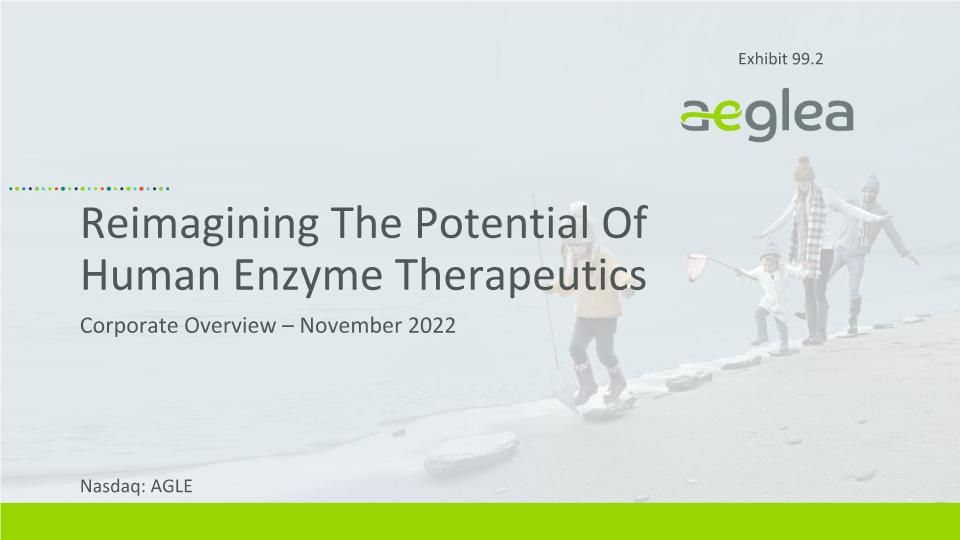
Reimagining The Potential Of Human Enzyme Therapeutics Corporate Overview – November 2022 Nasdaq: AGLE Exhibit 99.2
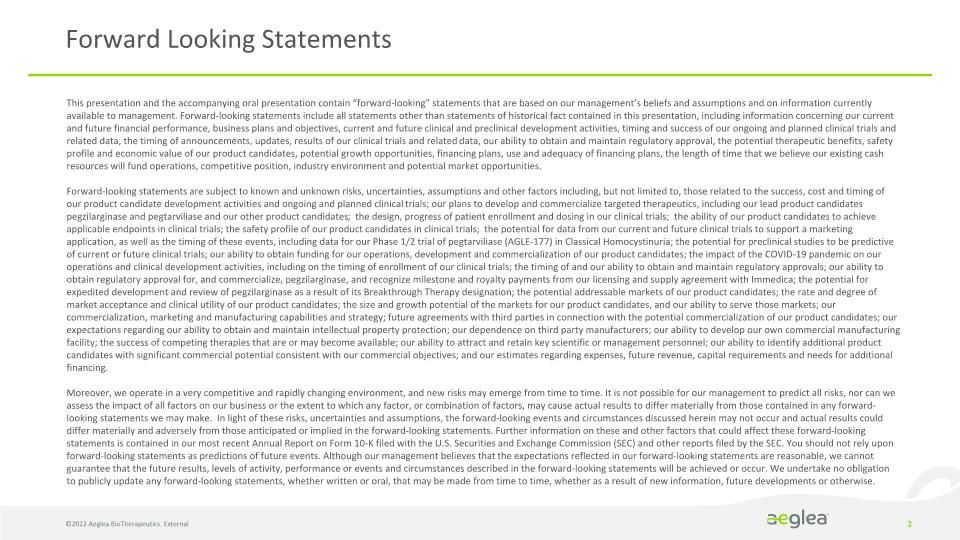
Forward Looking Statements ©2022 Aeglea BioTherapeutics. External This presentation and the accompanying oral presentation contain “forward-looking” statements that are based on our management’s beliefs and assumptions and on information currently available to management. Forward-looking statements include all statements other than statements of historical fact contained in this presentation, including information concerning our current and future financial performance, business plans and objectives, current and future clinical and preclinical development activities, timing and success of our ongoing and planned clinical trials and related data, the timing of announcements, updates, results of our clinical trials and related data, our ability to obtain and maintain regulatory approval, the potential therapeutic benefits, safety profile and economic value of our product candidates, potential growth opportunities, financing plans, use and adequacy of financing plans, the length of time that we believe our existing cash resources will fund operations, competitive position, industry environment and potential market opportunities. Forward-looking statements are subject to known and unknown risks, uncertainties, assumptions and other factors including, but not limited to, those related to the success, cost and timing of our product candidate development activities and ongoing and planned clinical trials; our plans to develop and commercialize targeted therapeutics, including our lead product candidates pegzilarginase and pegtarviliase and our other product candidates; the design, progress of patient enrollment and dosing in our clinical trials; the ability of our product candidates to achieve applicable endpoints in clinical trials; the safety profile of our product candidates in clinical trials; the potential for data from our current and future clinical trials to support a marketing application, as well as the timing of these events, including data for our Phase 1/2 trial of pegtarviliase (AGLE-177) in Classical Homocystinuria; the potential for preclinical studies to be predictive of current or future clinical trials; our ability to obtain funding for our operations, development and commercialization of our product candidates; the impact of the COVID-19 pandemic on our operations and clinical development activities, including on the timing of enrollment of our clinical trials; the timing of and our ability to obtain and maintain regulatory approvals; our ability to obtain regulatory approval for, and commercialize, pegzilarginase, and recognize milestone and royalty payments from our licensing and supply agreement with Immedica; the potential for expedited development and review of pegzilarginase as a result of its Breakthrough Therapy designation; the potential addressable markets of our product candidates; the rate and degree of market acceptance and clinical utility of our product candidates; the size and growth potential of the markets for our product candidates, and our ability to serve those markets; our commercialization, marketing and manufacturing capabilities and strategy; future agreements with third parties in connection with the potential commercialization of our product candidates; our expectations regarding our ability to obtain and maintain intellectual property protection; our dependence on third party manufacturers; our ability to develop our own commercial manufacturing facility; the success of competing therapies that are or may become available; our ability to attract and retain key scientific or management personnel; our ability to identify additional product candidates with significant commercial potential consistent with our commercial objectives; and our estimates regarding expenses, future revenue, capital requirements and needs for additional financing. Moreover, we operate in a very competitive and rapidly changing environment, and new risks may emerge from time to time. It is not possible for our management to predict all risks, nor can we assess the impact of all factors on our business or the extent to which any factor, or combination of factors, may cause actual results to differ materially from those contained in any forward-looking statements we may make. In light of these risks, uncertainties and assumptions, the forward-looking events and circumstances discussed herein may not occur and actual results could differ materially and adversely from those anticipated or implied in the forward-looking statements. Further information on these and other factors that could affect these forward-looking statements is contained in our most recent Annual Report on Form 10-K filed with the U.S. Securities and Exchange Commission (SEC) and other reports filed by the SEC. You should not rely upon forward-looking statements as predictions of future events. Although our management believes that the expectations reflected in our forward-looking statements are reasonable, we cannot guarantee that the future results, levels of activity, performance or events and circumstances described in the forward-looking statements will be achieved or occur. We undertake no obligation to publicly update any forward-looking statements, whether written or oral, that may be made from time to time, whether as a result of new information, future developments or otherwise.
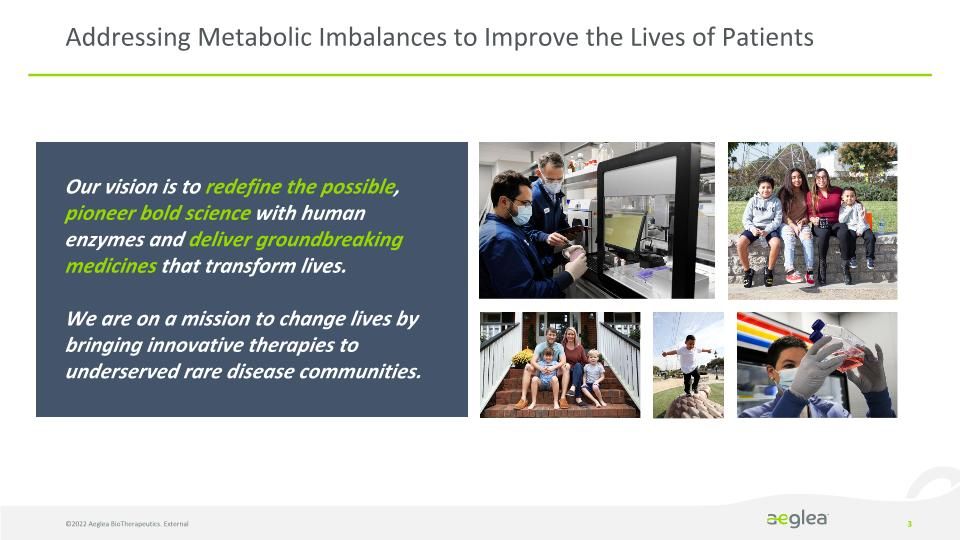
Addressing Metabolic Imbalances to Improve the Lives of Patients ©2022 Aeglea BioTherapeutics. External Our vision is to redefine the possible, pioneer bold science with human enzymes and deliver groundbreaking medicines that transform lives. We are on a mission to change lives by bringing innovative therapies to underserved rare disease communities.
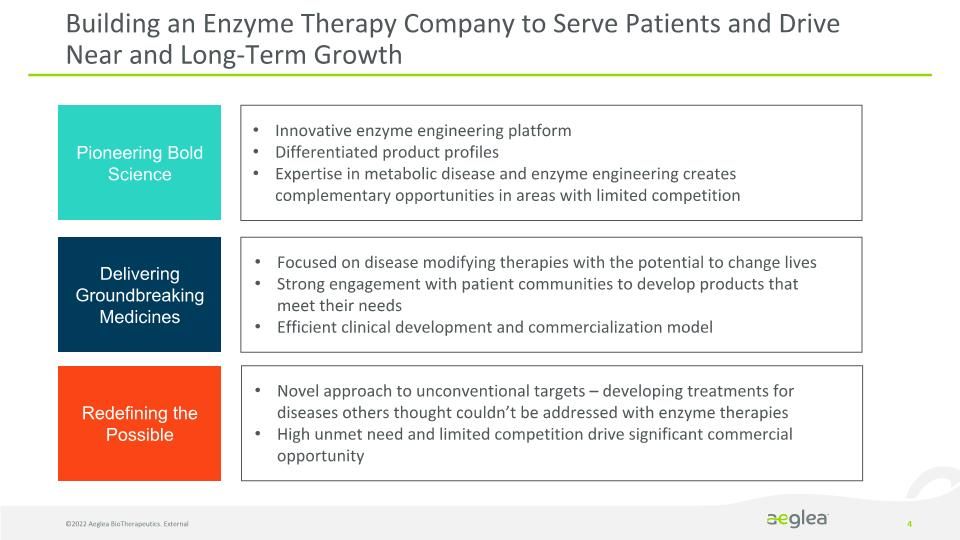
©2022 Aeglea BioTherapeutics. External Building an Enzyme Therapy Company to Serve Patients and Drive Near and Long-Term Growth Pioneering Bold Science Delivering Groundbreaking Medicines Redefining the Possible Innovative enzyme engineering platform Differentiated product profiles Expertise in metabolic disease and enzyme engineering creates complementary opportunities in areas with limited competition Novel approach to unconventional targets – developing treatments for diseases others thought couldn’t be addressed with enzyme therapies High unmet need and limited competition drive significant commercial opportunity Focused on disease modifying therapies with the potential to change lives Strong engagement with patient communities to develop products that meet their needs Efficient clinical development and commercialization model
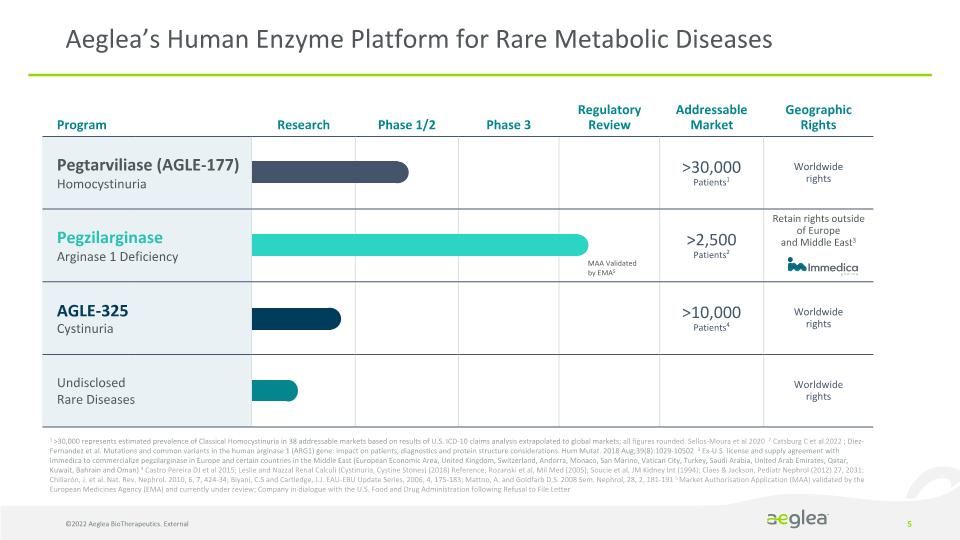
Program Research Phase 1/2 Phase 3 Regulatory Review Addressable Market Geographic Rights Pegtarviliase (AGLE-177) Homocystinuria >30,000 Patients1 Worldwide rights Pegzilarginase Arginase 1 Deficiency >2,500 Patients2 Retain rights outside of Europe �and Middle East3 AGLE-325 Cystinuria Cystinuria >10,000 Patients4 Worldwide rights Undisclosed �Rare Diseases Undisclosed �Rare Diseases Worldwide rights Aeglea’s Human Enzyme Platform for Rare Metabolic Diseases 1 >30,000 represents estimated prevalence of Classical Homocystinuria in 38 addressable markets based on results of U.S. ICD-10 claims analysis extrapolated to global markets; all figures rounded. Sellos-Moura et al 2020 2 Catsburg C et al 2022 ; Diez-Fernandez et al. Mutations and common variants in the human arginase 1 (ARG1) gene: impact on patients, diagnostics and protein structure considerations. Hum Mutat. 2018 Aug;39(8):1029-10502 3 Ex-U.S. license and supply agreement with Immedica to commercialize pegzilarginase in Europe and certain countries in the Middle East (European Economic Area, United Kingdom, Switzerland, Andorra, Monaco, San Marino, Vatican City, Turkey, Saudi Arabia, United Arab Emirates, Qatar, Kuwait, Bahrain and Oman) 4 Castro Pereira DJ et al 2015; Leslie and Nazzal Renal Calculi (Cystinuria, Cystine Stones) (2018) Reference; Rozanski et al, Mil Med (2005); Soucie et al, JM Kidney Int (1994); Claes & Jackson, Pediatr Nephrol (2012) 27, 2031; Chillarón, J. et al. Nat. Rev. Nephrol. 2010, 6, 7, 424-34; Biyani, C.S and Cartledge, J.J. EAU-EBU Update Series, 2006, 4, 175-183; Mattoo, A. and Goldfarb D.S. 2008 Sem. Nephrol, 28, 2, 181-191 5 Market Authorisation Application (MAA) validated by the European Medicines Agency (EMA) and currently under review; Company in dialogue with the U.S. Food and Drug Administration following Refusal to File Letter ©2022 Aeglea BioTherapeutics. External MAA Validated by EMA5
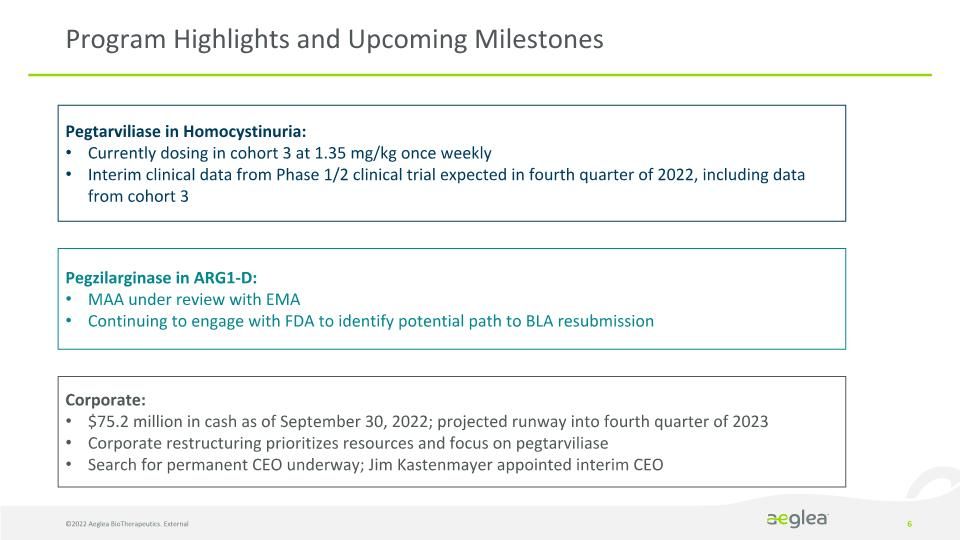
©2022 Aeglea BioTherapeutics. External Program Highlights and Upcoming Milestones Pegtarviliase in Homocystinuria: Currently dosing in cohort 3 at 1.35 mg/kg once weekly Interim clinical data from Phase 1/2 clinical trial expected in fourth quarter of 2022, including data from cohort 3 Pegzilarginase in ARG1-D: MAA under review with EMA Continuing to engage with FDA to identify potential path to BLA resubmission Corporate: $75.2 million in cash as of September 30, 2022; projected runway into fourth quarter of 2023 Corporate restructuring prioritizes resources and focus on pegtarviliase Search for permanent CEO underway; Jim Kastenmayer appointed interim CEO
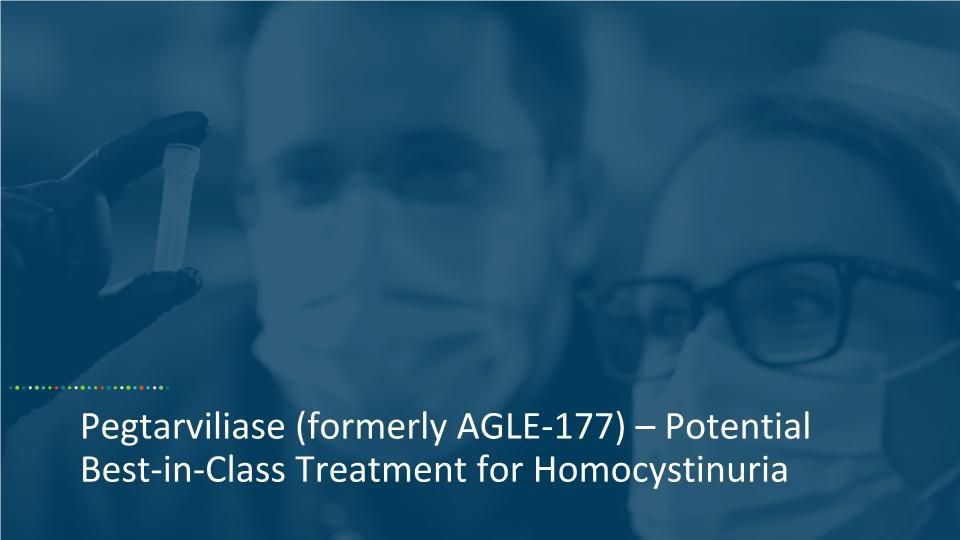
Pegtarviliase (formerly AGLE-177) – Potential Best-in-Class Treatment for Homocystinuria
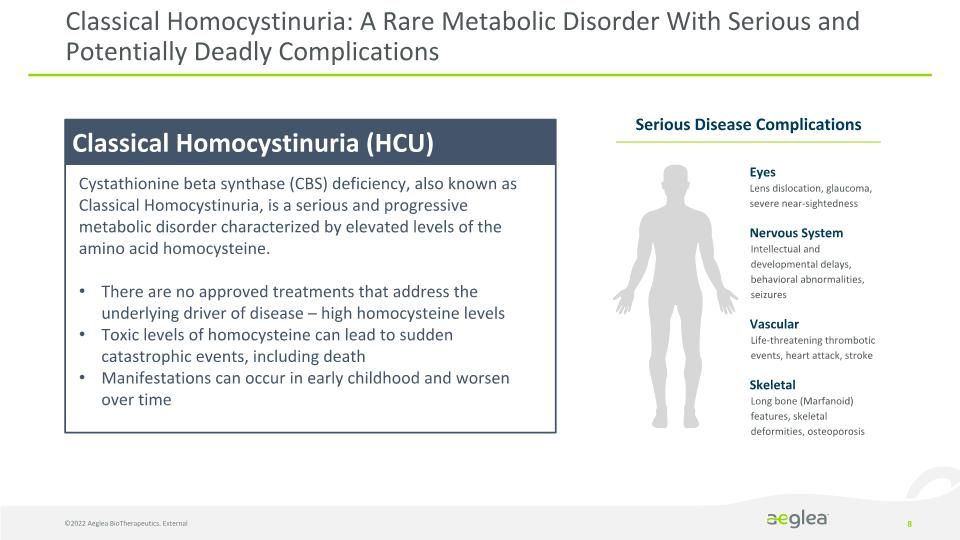
Classical Homocystinuria (HCU) Classical Homocystinuria: A Rare Metabolic Disorder With Serious and Potentially Deadly Complications Cystathionine beta synthase (CBS) deficiency, also known as Classical Homocystinuria, is a serious and progressive metabolic disorder characterized by elevated levels of the amino acid homocysteine. There are no approved treatments that address the underlying driver of disease – high homocysteine levels Toxic levels of homocysteine can lead to sudden catastrophic events, including death Manifestations can occur in early childhood and worsen over time ©2022 Aeglea BioTherapeutics. External Serious Disease Complications Eyes Lens dislocation, glaucoma, severe near-sightedness Nervous System Intellectual and developmental delays, behavioral abnormalities, seizures Vascular Life-threatening thrombotic events, heart attack, stroke Skeletal Long bone (Marfanoid) features, skeletal deformities, osteoporosis
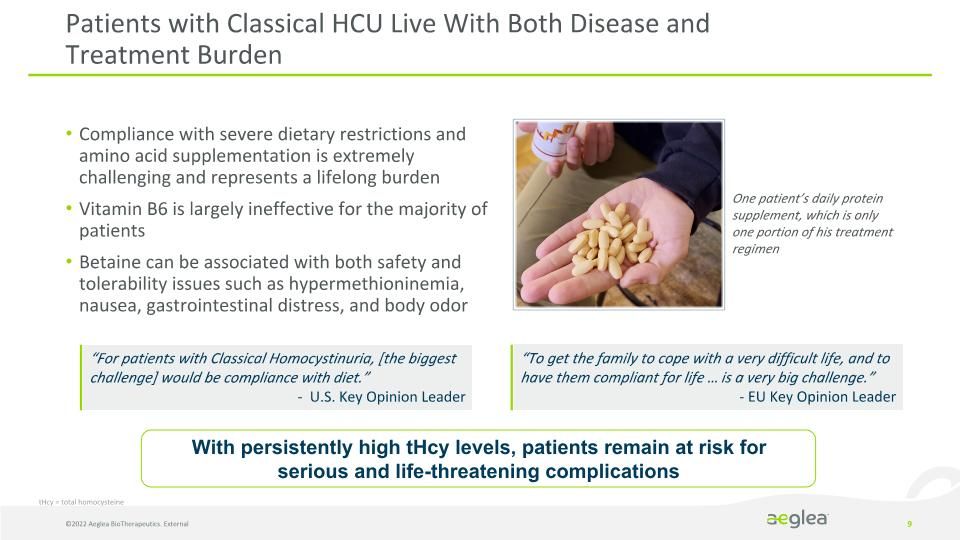
With persistently high tHcy levels, patients remain at risk for�serious and life-threatening complications ©2022 Aeglea BioTherapeutics. External Compliance with severe dietary restrictions and amino acid supplementation is extremely challenging and represents a lifelong burden Vitamin B6 is largely ineffective for the majority of patients Betaine can be associated with both safety and tolerability issues such as hypermethioninemia, nausea, gastrointestinal distress, and body odor Patients with Classical HCU Live With Both Disease and Treatment Burden “To get the family to cope with a very difficult life, and to have them compliant for life … is a very big challenge.” - EU Key Opinion Leader “For patients with Classical Homocystinuria, [the biggest challenge] would be compliance with diet.” - U.S. Key Opinion Leader One patient’s daily protein supplement, which is only one portion of his treatment regimen tHcy = total homocysteine
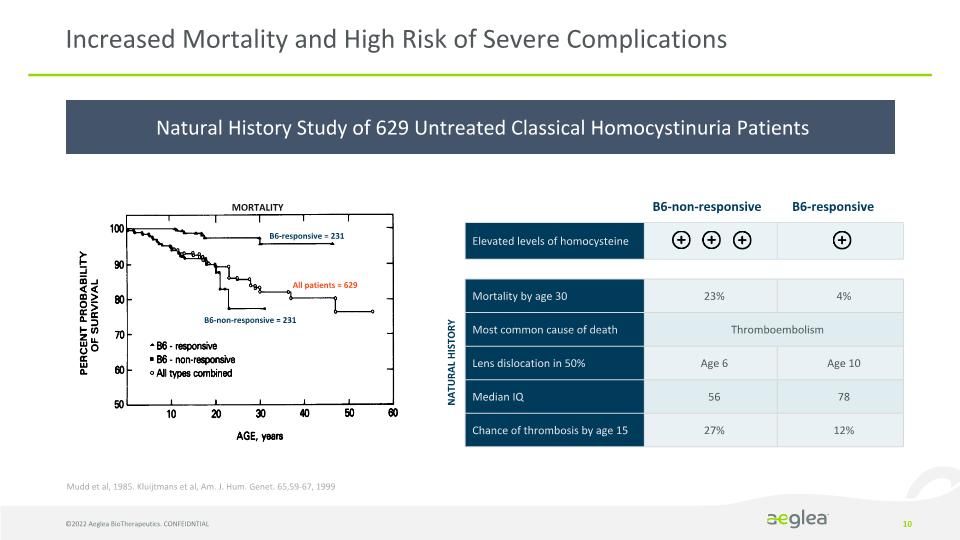
Natural History Study of 629 Untreated Classical Homocystinuria Patients Elevated levels of homocysteine Mortality by age 30 23% 4% Most common cause of death Thromboembolism Lens dislocation in 50% Age 6 Age 10 Median IQ 56 78 Chance of thrombosis by age 15 27% 12% Increased Mortality and High Risk of Severe Complications B6-responsive = 231 All patients = 629 B6-non-responsive = 231 MORTALITY NATURAL HISTORY Mudd et al, 1985. Kluijtmans et al, Am. J. Hum. Genet. 65,59-67, 1999 B6-non-responsive B6-responsive ©2022 Aeglea BioTherapeutics. CONFEIDNTIAL
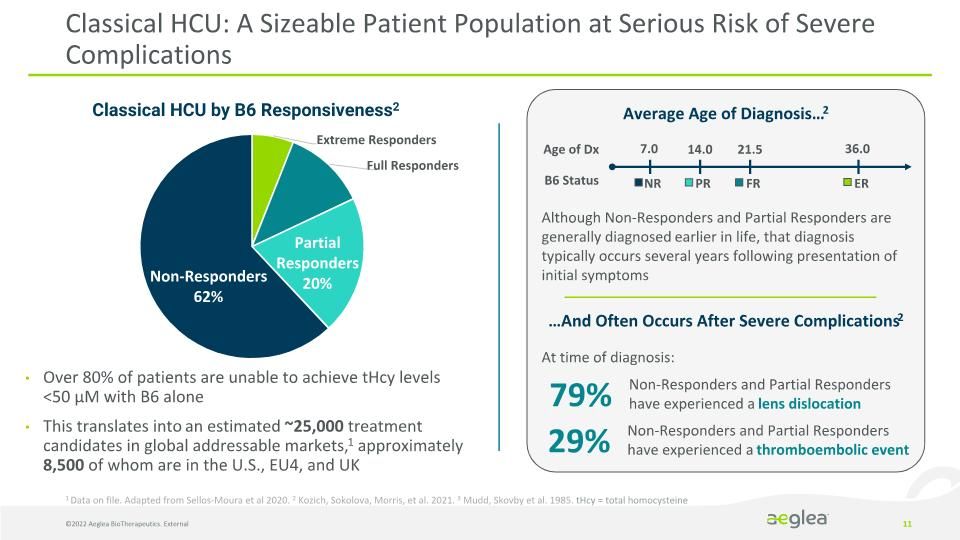
©2022 Aeglea BioTherapeutics. External Classical HCU: A Sizeable Patient Population at Serious Risk of Severe Complications Over 80% of patients are unable to achieve tHcy levels <50 µM with B6 alone This translates into an estimated ~25,000 treatment candidates in global addressable markets,1 approximately 8,500 of whom are in the U.S., EU4, and UK Average Age of Diagnosis…2 1 Data on file. Adapted from Sellos-Moura et al 2020. 2 Kozich, Sokolova, Morris, et al. 2021. 3 Mudd, Skovby et al. 1985. tHcy = total homocysteine …And Often Occurs After Severe Complications2 Although Non-Responders and Partial Responders are generally diagnosed earlier in life, that diagnosis typically occurs several years following presentation of initial symptoms At time of diagnosis: 79% Non-Responders and Partial Responders have experienced a lens dislocation 29% Non-Responders and Partial Responders have experienced a thromboembolic event 7.0 14.0 21.5 36.0 ER FR PR NR Age of Dx B6 Status Classical HCU by B6 Responsiveness2
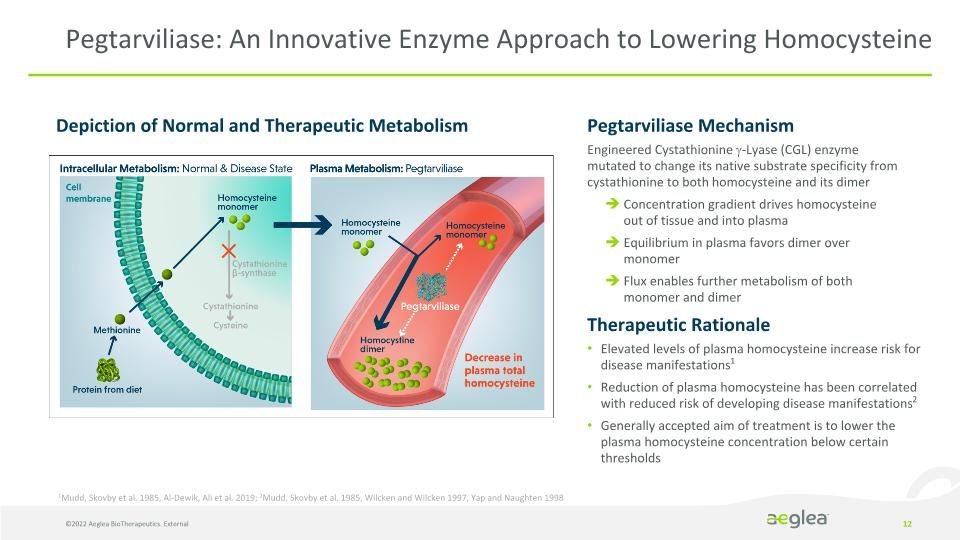
Pegtarviliase: An Innovative Enzyme Approach to Lowering Homocysteine Pegtarviliase Mechanism Engineered Cystathionine -Lyase (CGL) enzyme mutated to change its native substrate specificity from cystathionine to both homocysteine and its dimer Concentration gradient drives homocysteine out of tissue and into plasma Equilibrium in plasma favors dimer over monomer Flux enables further metabolism of both monomer and dimer 1Mudd, Skovby et al. 1985, Al-Dewik, Ali et al. 2019; 2Mudd, Skovby et al. 1985, Wilcken and Wilcken 1997, Yap and Naughten 1998 ©2022 Aeglea BioTherapeutics. External Therapeutic Rationale Elevated levels of plasma homocysteine increase risk for disease manifestations1 Reduction of plasma homocysteine has been correlated with reduced risk of developing disease manifestations2 Generally accepted aim of treatment is to lower the plasma homocysteine concentration below certain thresholds Depiction of Normal and Therapeutic Metabolism
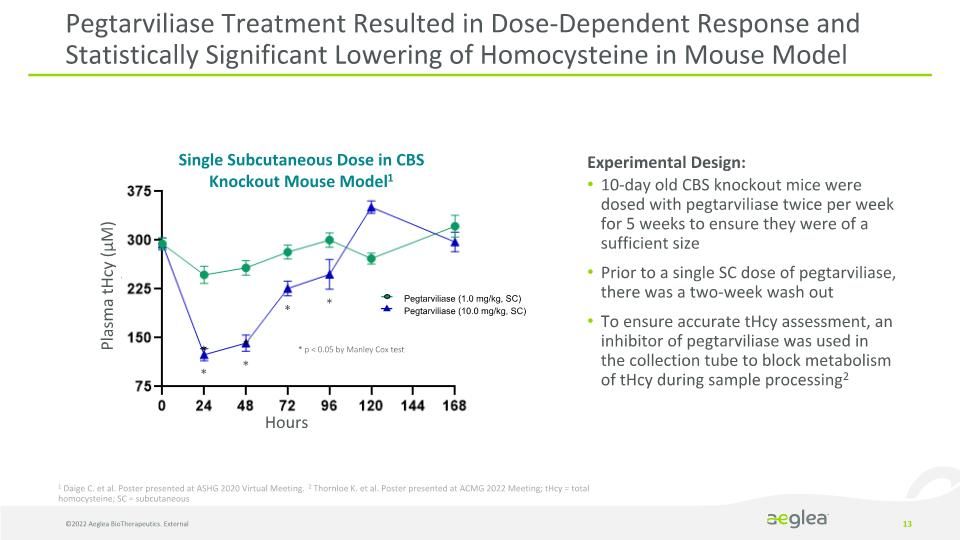
©2022 Aeglea BioTherapeutics. External Experimental Design: 10-day old CBS knockout mice were dosed with pegtarviliase twice per week for 5 weeks to ensure they were of a sufficient size Prior to a single SC dose of pegtarviliase, there was a two-week wash out To ensure accurate tHcy assessment, an inhibitor of pegtarviliase was used in the collection tube to block metabolism of tHcy during sample processing2 Pegtarviliase Treatment Resulted in Dose-Dependent Response and Statistically Significant Lowering of Homocysteine in Mouse Model Single Subcutaneous Dose in CBS Knockout Mouse Model1 * p < 0.05 by Manley Cox test Pegtarviliase (1.0 mg/kg, SC) Pegtarviliase (10.0 mg/kg, SC) Plasma tHcy (µM) Hours 1 Daige C. et al. Poster presented at ASHG 2020 Virtual Meeting. 2 Thornloe K. et al. Poster presented at ACMG 2022 Meeting; tHcy = total homocysteine; SC = subcutaneous * * * *
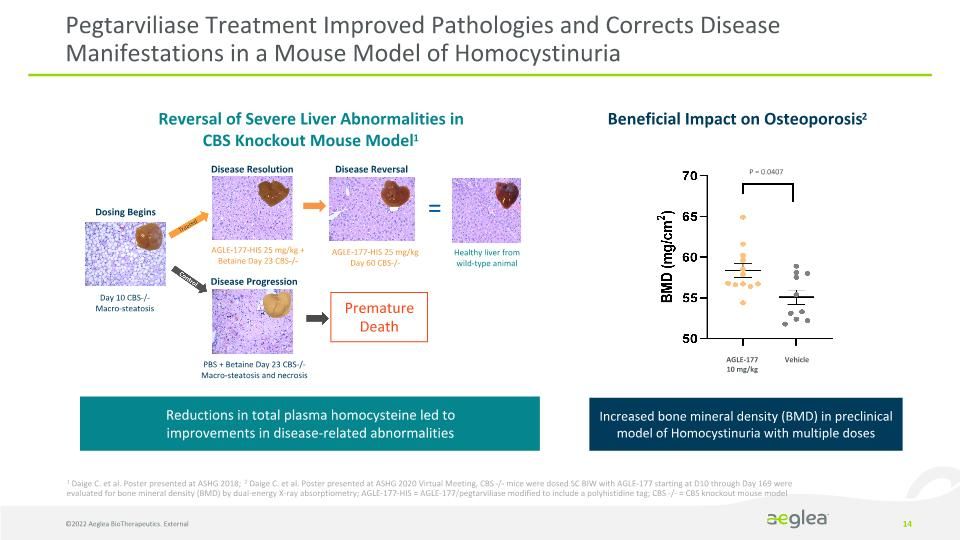
Pegtarviliase Treatment Improved Pathologies and Corrects Disease Manifestations in a Mouse Model of Homocystinuria ©2022 Aeglea BioTherapeutics. External Disease Resolution Disease Reversal Dosing Begins Day 10 CBS-/- Macro-steatosis Disease Progression AGLE-177-HIS 25 mg/kg + Betaine Day 23 CBS-/- AGLE-177-HIS 25 mg/kg Day 60 CBS-/- PBS + Betaine Day 23 CBS-/- Macro-steatosis and necrosis Premature Death Healthy liver from wild-type animal Reversal of Severe Liver Abnormalities in �CBS Knockout Mouse Model1 Reductions in total plasma homocysteine led to �improvements in disease-related abnormalities P = 0.0407 AGLE-177 10 mg/kg Vehicle Beneficial Impact on Osteoporosis2 Increased bone mineral density (BMD) in preclinical model of Homocystinuria with multiple doses 1 Daige C. et al. Poster presented at ASHG 2018; 2 Daige C. et al. Poster presented at ASHG 2020 Virtual Meeting, CBS -/- mice were dosed SC BIW with AGLE-177 starting at D10 through Day 169 were evaluated for bone mineral density (BMD) by dual-energy X-ray absorptiometry; AGLE-177-HIS = AGLE-177/pegtarviliase modified to include a polyhistidine tag; CBS -/- = CBS knockout mouse model
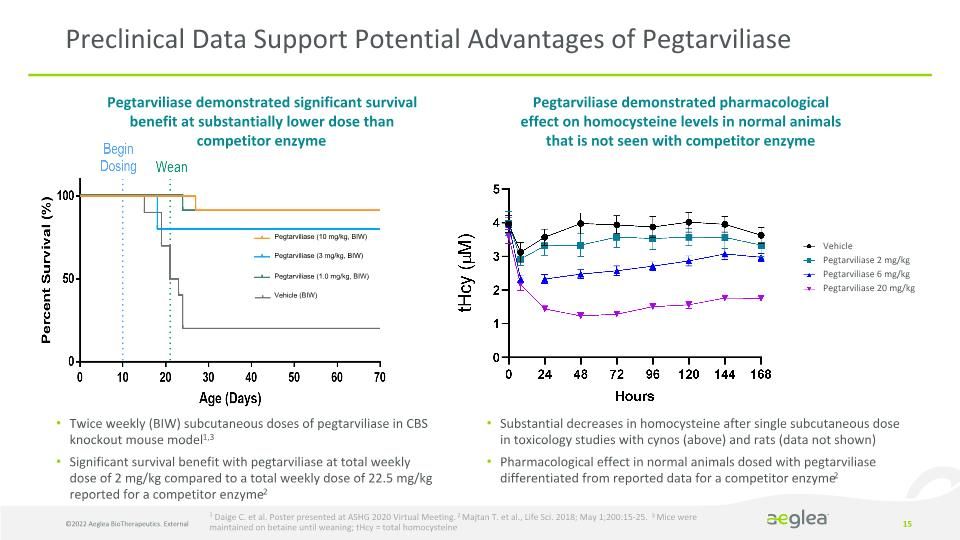
Preclinical Data Support Potential Advantages of Pegtarviliase Pegtarviliase demonstrated significant survival benefit at substantially lower dose than competitor enzyme 1 Daige C. et al. Poster presented at ASHG 2020 Virtual Meeting. 2 Majtan T. et al., Life Sci. 2018; May 1;200:15-25. 3 Mice were maintained on betaine until weaning; tHcy = total homocysteine Pegtarviliase (10 mg/kg, BIW) Pegtarviliase (3 mg/kg, BIW) Pegtarviliase (1.0 mg/kg, BIW) Vehicle (BIW) Twice weekly (BIW) subcutaneous doses of pegtarviliase in CBS knockout mouse model1,3 Significant survival benefit with pegtarviliase at total weekly dose of 2 mg/kg compared to a total weekly dose of 22.5 mg/kg reported for a competitor enzyme2 Pegtarviliase demonstrated pharmacological effect on homocysteine levels in normal animals that is not seen with competitor enzyme Substantial decreases in homocysteine after single subcutaneous dose in toxicology studies with cynos (above) and rats (data not shown) Pharmacological effect in normal animals dosed with pegtarviliase differentiated from reported data for a competitor enzyme2 ©2022 Aeglea BioTherapeutics. External Vehicle Pegtarviliase 2 mg/kg Pegtarviliase 6 mg/kg Pegtarviliase 20 mg/kg
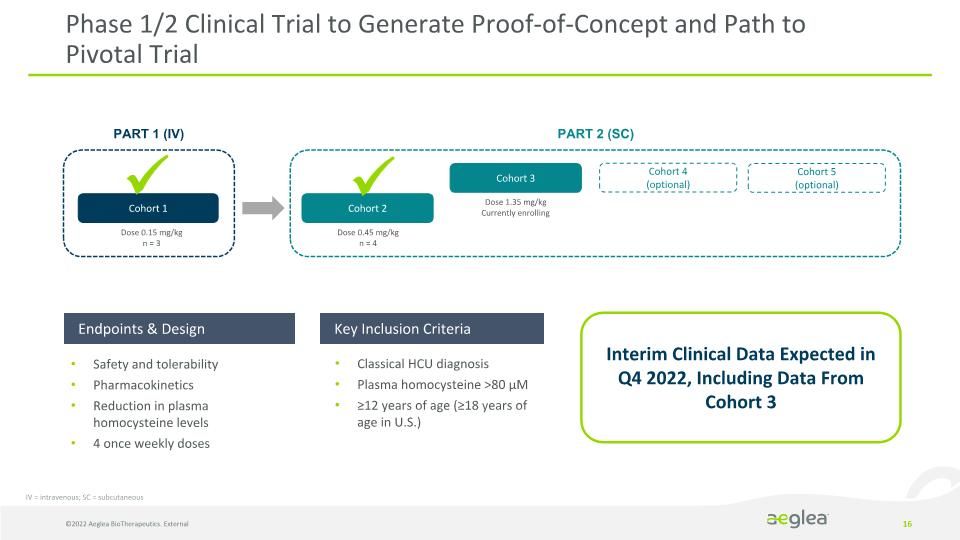
©2022 Aeglea BioTherapeutics. External Phase 1/2 Clinical Trial to Generate Proof-of-Concept and Path to Pivotal Trial Cohort 2 Cohort 3 PART 1 (IV) PART 2 (SC) Dose 0.45 mg/kg n = 4 Dose 1.35 mg/kg Currently enrolling Dose 0.15 mg/kg n = 3 Cohort 1 Cohort 5 (optional) Interim Clinical Data Expected in Q4 2022, Including Data From Cohort 3 IV = intravenous; SC = subcutaneous Cohort 4 (optional) Endpoints & Design Key Inclusion Criteria Safety and tolerability Pharmacokinetics Reduction in plasma homocysteine levels 4 once weekly doses Classical HCU diagnosis Plasma homocysteine >80 µM ≥12 years of age (≥18 years of age in U.S.)
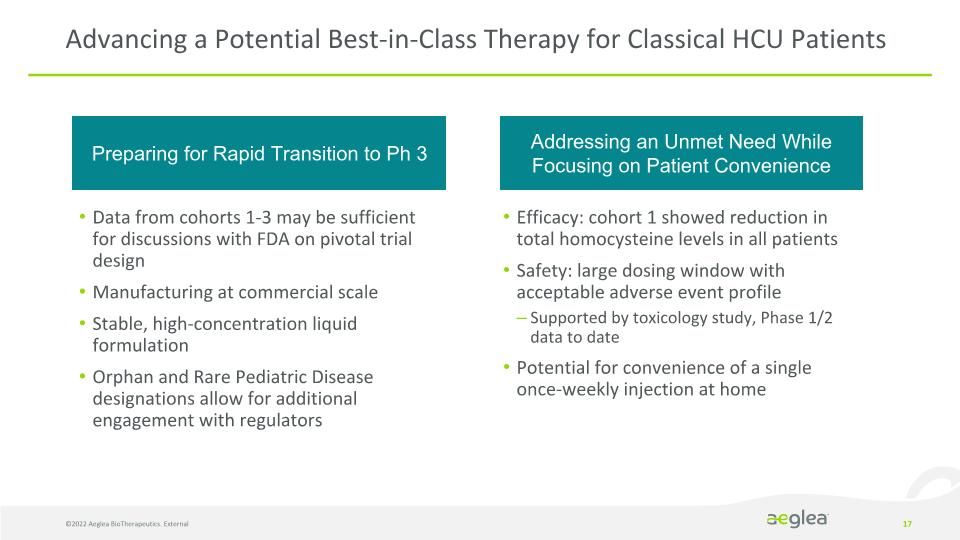
©2022 Aeglea BioTherapeutics. External Data from cohorts 1-3 may be sufficient for discussions with FDA on pivotal trial design Manufacturing at commercial scale Stable, high-concentration liquid formulation Orphan and Rare Pediatric Disease designations allow for additional engagement with regulators Advancing a Potential Best-in-Class Therapy for Classical HCU Patients Addressing an Unmet Need While Focusing on Patient Convenience Preparing for Rapid Transition to Ph 3 Efficacy: cohort 1 showed reduction in total homocysteine levels in all patients Safety: large dosing window with acceptable adverse event profile Supported by toxicology study, Phase 1/2 data to date Potential for convenience of a single once-weekly injection at home
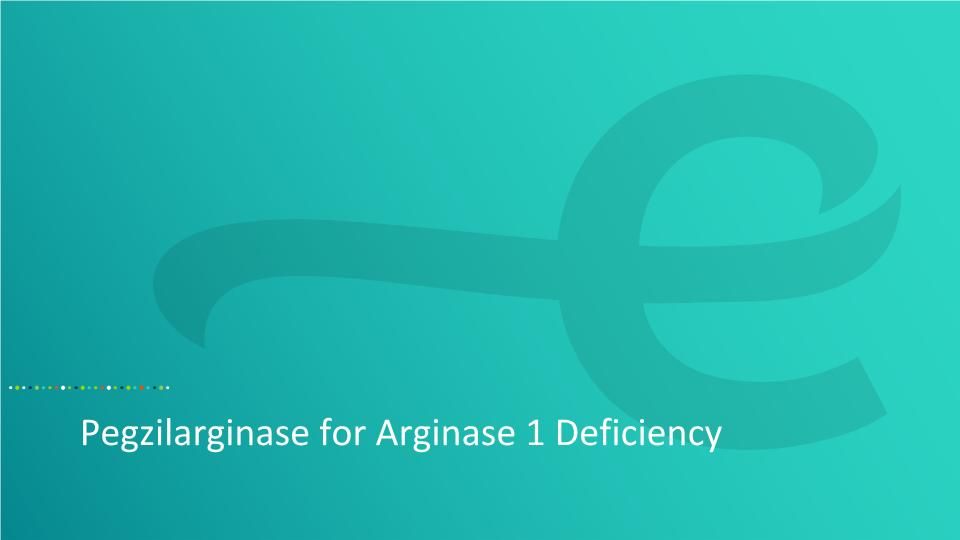
Pegzilarginase for Arginase 1 Deficiency
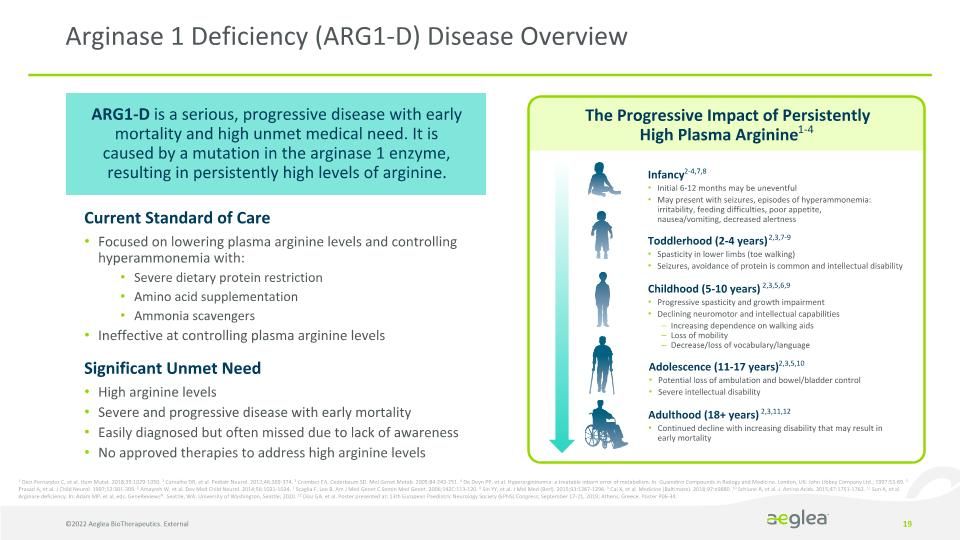
The Progressive Impact of Persistently �High Plasma Arginine1-4 Arginase 1 Deficiency (ARG1-D) Disease Overview Infancy2-4,7,8 Initial 6-12 months may be uneventful May present with seizures, episodes of hyperammonemia: irritability, feeding difficulties, poor appetite, nausea/vomiting, decreased alertness Toddlerhood (2-4 years) 2,3,7-9 Spasticity in lower limbs (toe walking) Seizures, avoidance of protein is common and intellectual disability Childhood (5-10 years) 2,3,5,6,9 Progressive spasticity and growth impairment Declining neuromotor and intellectual capabilities Increasing dependence on walking aids Loss of mobility Decrease/loss of vocabulary/language Adolescence (11-17 years)2,3,5,10 Potential loss of ambulation and bowel/bladder control Severe intellectual disability Adulthood (18+ years) 2,3,11,12 Continued decline with increasing disability that may result in �early mortality 1 Diez-Fernandez C, et al. Hum Mutat. 2018;39:1029-1050. 2 Carvalho DR, et al. Pediatr Neurol. 2012;46:369-374. 3 Crombez EA, Cederbaum SD. Mol Genet Metab. 2005;84:243-251. 4 De Deyn PP, et al. Hyperargininemia: a treatable inborn error of metabolism. In: Guanidino Compounds in Biology and Medicine. London, UK: John Libbey Company Ltd.; 1997:53-69. 5 Prasad A, et al. J Child Neurol. 1997;12:301-309. 6 Amayreh W, et al. Dev Med Child Neurol. 2014;56:1021-1024. 7 Scaglia F, Lee B. Am J Med Genet C Semin Med Genet. 2006;142C:113-120. 8 Sin YY, et al. J Mol Med (Berl). 2015;93:1287-1296. 9 Cai X, et al. Medicine (Baltimore). 2018;97:e9880. 10 Schlune A, et al. J. Amino Acids. 2015;47:1751-1762. 11 Sun A, et al. Arginase deficiency. In: Adam MP, et al, eds. GeneReviews®. Seattle, WA: University of Washington, Seattle; 2020. 12 Diaz GA, et al. Poster presented at: 13th European Paediatric Neurology Society (EPNS) Congress; September 17-21, 2019; Athens, Greece. Poster P06-34. Current Standard of Care Focused on lowering plasma arginine levels and controlling hyperammonemia with: Severe dietary protein restriction Amino acid supplementation Ammonia scavengers Ineffective at controlling plasma arginine levels Significant Unmet Need High arginine levels Severe and progressive disease with early mortality Easily diagnosed but often missed due to lack of awareness No approved therapies to address high arginine levels ARG1-D is a serious, progressive disease with early mortality and high unmet medical need. It is caused by a mutation in the arginase 1 enzyme, resulting in persistently high levels of arginine. ©2022 Aeglea BioTherapeutics. External
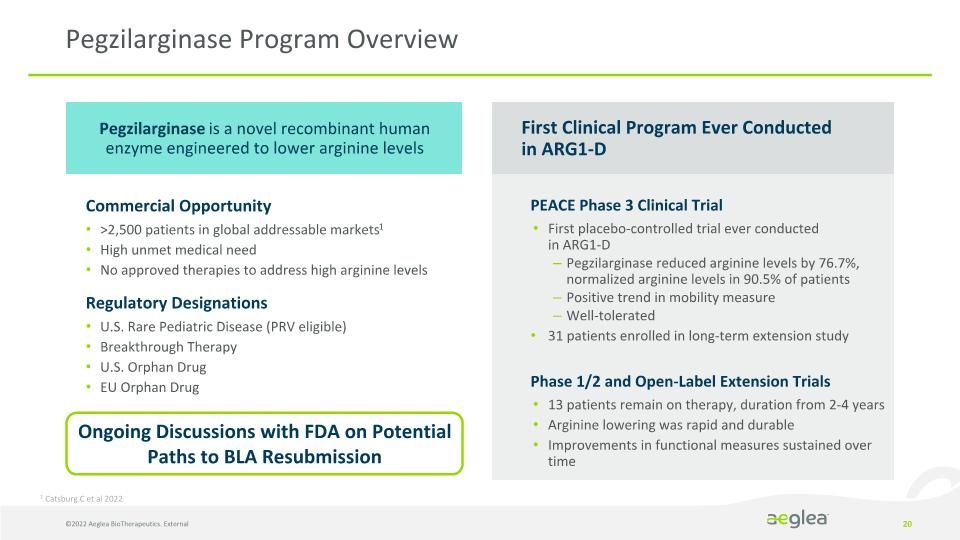
Pegzilarginase Program Overview Commercial Opportunity >2,500 patients in global addressable markets1 High unmet medical need No approved therapies to address high arginine levels Regulatory Designations U.S. Rare Pediatric Disease (PRV eligible) Breakthrough Therapy U.S. Orphan Drug EU Orphan Drug Pegzilarginase is a novel recombinant human enzyme engineered to lower arginine levels Ongoing Discussions with FDA on Potential Paths to BLA Resubmission PEACE Phase 3 Clinical Trial First placebo-controlled trial ever conducted �in ARG1-D Pegzilarginase reduced arginine levels by 76.7%, normalized arginine levels in 90.5% of patients Positive trend in mobility measure Well-tolerated 31 patients enrolled in long-term extension study Phase 1/2 and Open-Label Extension Trials 13 patients remain on therapy, duration from 2-4 years Arginine lowering was rapid and durable Improvements in functional measures sustained over time First Clinical Program Ever Conducted �in ARG1-D ©2022 Aeglea BioTherapeutics. External 1 Catsburg C et al 2022
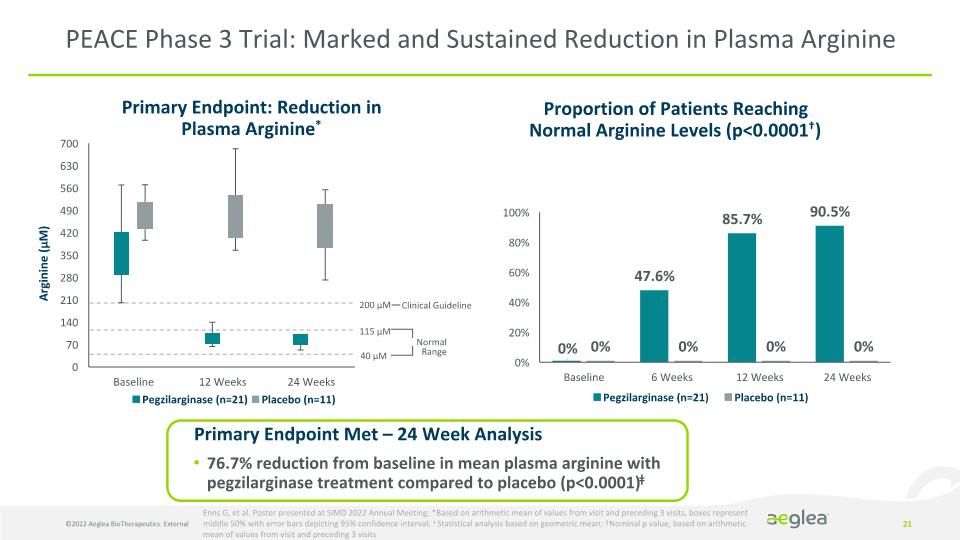
PEACE Phase 3 Trial: Marked and Sustained Reduction in Plasma Arginine Primary Endpoint: Reduction in Plasma Arginine* Enns G, et al. Poster presented at SIMD 2022 Annual Meeting; *Based on arithmetic mean of values from visit and preceding 3 visits, boxes represent middle 50% with error bars depicting 95% confidence interval; ǂ Statistical analysis based on geometric mean; †Nominal p value, based on arithmetic mean of values from visit and preceding 3 visits 200 µM 115 µM 40 µM Normal Range Clinical Guideline ©2022 Aeglea BioTherapeutics. External Primary Endpoint Met – 24 Week Analysis 76.7% reduction from baseline in mean plasma arginine with pegzilarginase treatment compared to placebo (p<0.0001)ǂ Proportion of Patients Reaching Normal Arginine Levels (p<0.0001†)
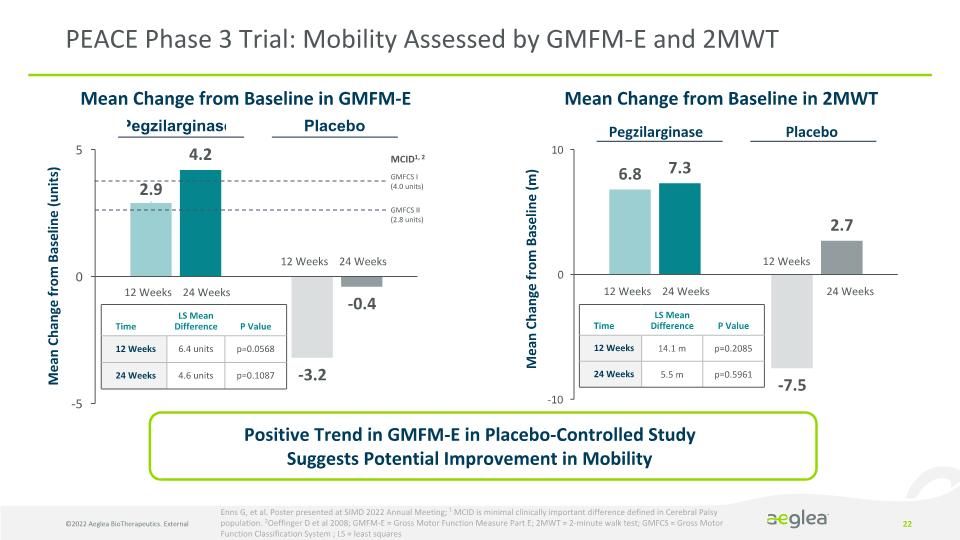
PEACE Phase 3 Trial: Mobility Assessed by GMFM-E and 2MWT Pegzilarginase Placebo 12 Weeks 24 Weeks 12 Weeks 24 Weeks MCID1, 2 GMFCS I (4.0 units) GMFCS II (2.8 units) Positive Trend in GMFM-E in Placebo-Controlled Study Suggests Potential Improvement in Mobility Time LS Mean Difference P Value 12 Weeks 6.4 units p=0.0568 24 Weeks 4.6 units p=0.1087 Pegzilarginase Placebo 12 Weeks 24 Weeks 12 Weeks 24 Weeks Mean Change from Baseline in 2MWT Time LS Mean Difference P Value 12 Weeks 14.1 m p=0.2085 24 Weeks 5.5 m p=0.5961 Mean Change from Baseline in GMFM-E Enns G, et al. Poster presented at SIMD 2022 Annual Meeting; 1 MCID is minimal clinically important difference defined in Cerebral Palsy population. 2Oeffinger D et al 2008; GMFM-E = Gross Motor Function Measure Part E; 2MWT = 2-minute walk test; GMFCS = Gross Motor Function Classification System ; LS = least squares ©2022 Aeglea BioTherapeutics. External
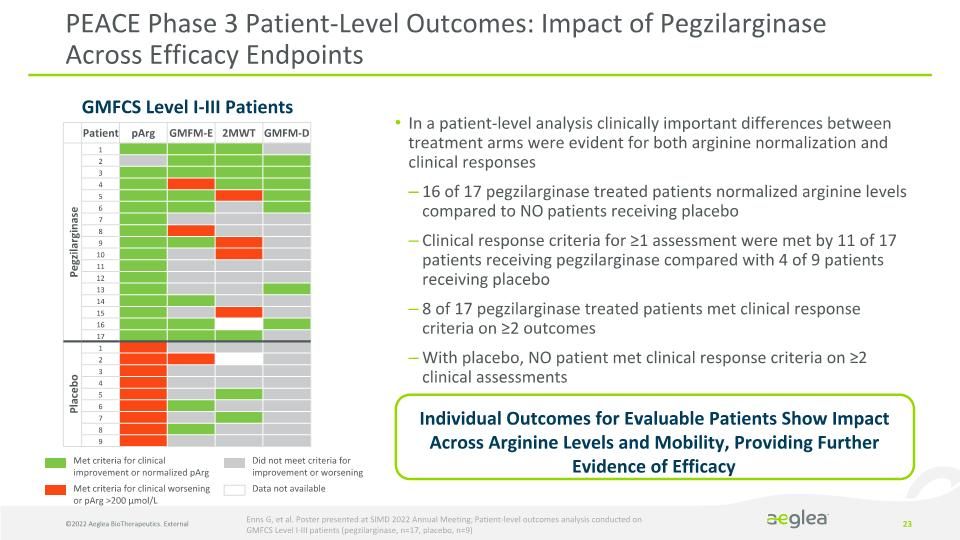
©2022 Aeglea BioTherapeutics. External In a patient-level analysis clinically important differences between treatment arms were evident for both arginine normalization and clinical responses 16 of 17 pegzilarginase treated patients normalized arginine levels compared to NO patients receiving placebo Clinical response criteria for ≥1 assessment were met by 11 of 17 patients receiving pegzilarginase compared with 4 of 9 patients receiving placebo 8 of 17 pegzilarginase treated patients met clinical response criteria on ≥2 outcomes With placebo, NO patient met clinical response criteria on ≥2 clinical assessments PEACE Phase 3 Patient-Level Outcomes: Impact of Pegzilarginase Across Efficacy Endpoints Enns G, et al. Poster presented at SIMD 2022 Annual Meeting; Patient-level outcomes analysis conducted on GMFCS Level I-III patients (pegzilarginase, n=17, placebo, n=9) Individual Outcomes for Evaluable Patients Show Impact Across Arginine Levels and Mobility, Providing Further Evidence of Efficacy GMFCS Level I-III Patients Patient pArg GMFM-E 2MWT GMFM-D Pegzilarginase 1 2 3 4 5 6 7 8 9 10 11 12 13 14 15 16 17 Placebo 1 2 3 4 5 6 7 8 9 Met criteria for clinical improvement or normalized pArg Met criteria for clinical worsening or pArg >200 µmol/L Did not meet criteria for improvement or worsening Data not available
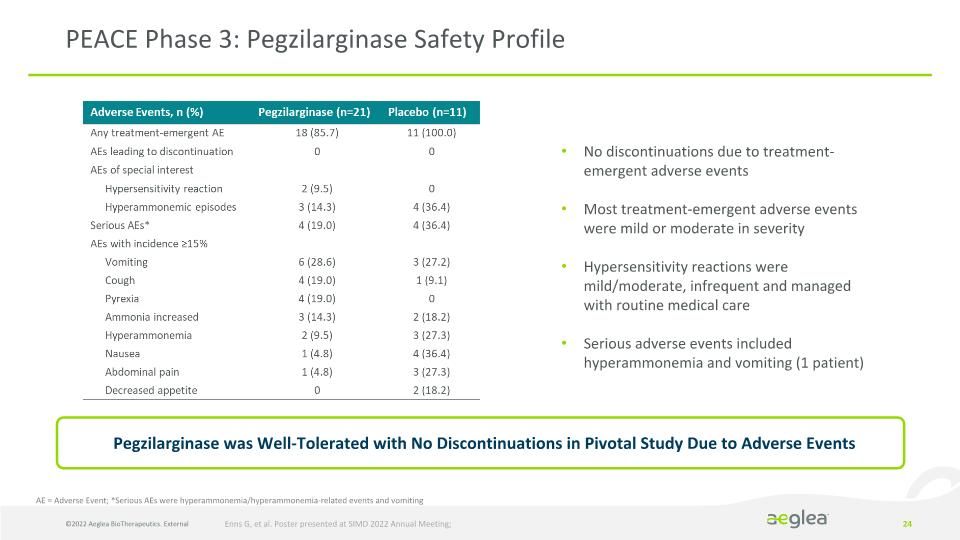
PEACE Phase 3: Pegzilarginase Safety Profile AE = Adverse Event; *Serious AEs were hyperammonemia/hyperammonemia-related events and vomiting Pegzilarginase was Well-Tolerated with No Discontinuations in Pivotal Study Due to Adverse Events No discontinuations due to treatment-emergent adverse events Most treatment-emergent adverse events were mild or moderate in severity Hypersensitivity reactions were mild/moderate, infrequent and managed with routine medical care Serious adverse events included hyperammonemia and vomiting (1 patient) ©2022 Aeglea BioTherapeutics. External Enns G, et al. Poster presented at SIMD 2022 Annual Meeting;
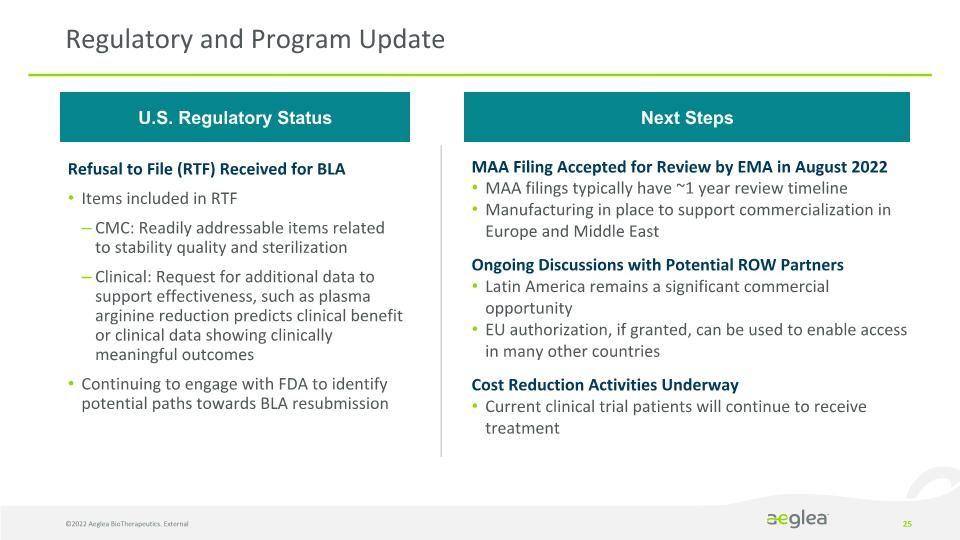
©2022 Aeglea BioTherapeutics. External Regulatory and Program Update Refusal to File (RTF) Received for BLA Items included in RTF CMC: Readily addressable items related to stability quality and sterilization Clinical: Request for additional data to support effectiveness, such as plasma arginine reduction predicts clinical benefit or clinical data showing clinically meaningful outcomes Continuing to engage with FDA to identify potential paths towards BLA resubmission U.S. Regulatory Status Next Steps MAA Filing Accepted for Review by EMA in August 2022 MAA filings typically have ~1 year review timeline Manufacturing in place to support commercialization in Europe and Middle East Ongoing Discussions with Potential ROW Partners Latin America remains a significant commercial opportunity EU authorization, if granted, can be used to enable access in many other countries Cost Reduction Activities Underway Current clinical trial patients will continue to receive treatment
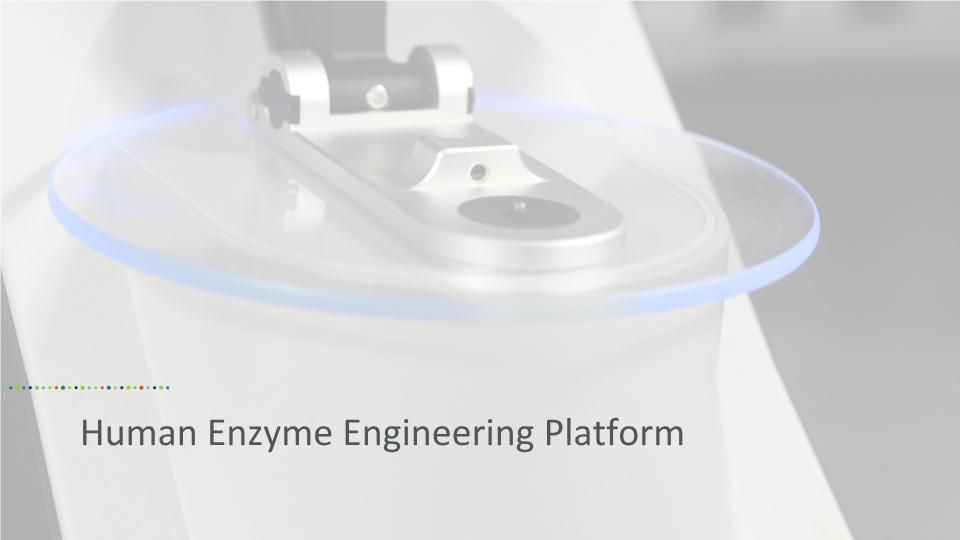
Human Enzyme Engineering Platform
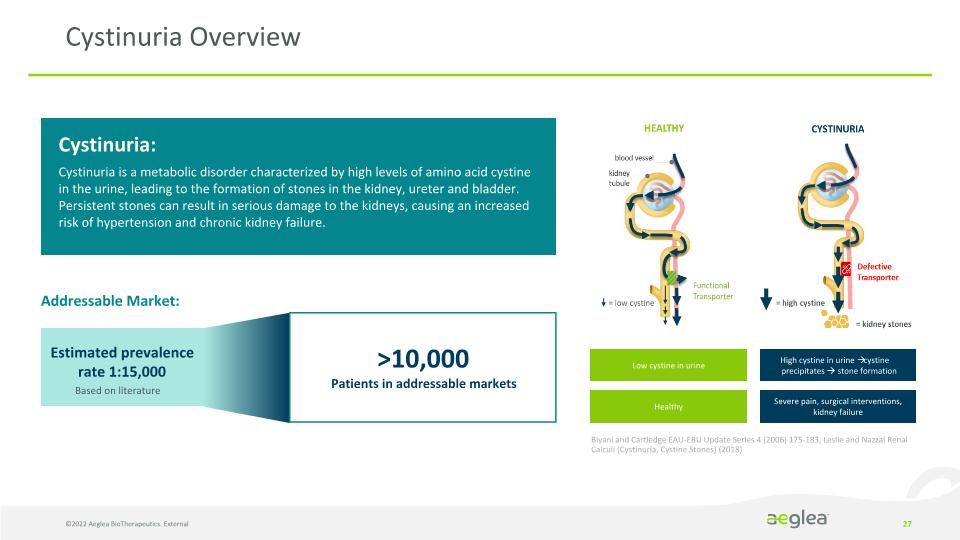
Cystinuria Overview Cystinuria: Cystinuria is a metabolic disorder characterized by high levels of amino acid cystine in the urine, leading to the formation of stones in the kidney, ureter and bladder. Persistent stones can result in serious damage to the kidneys, causing an increased risk of hypertension and chronic kidney failure. Addressable Market: Estimated prevalence rate 1:15,000 Based on literature >10,000 Patients in addressable markets Low cystine in urine Healthy High cystine in urine cystine �precipitates stone formation Severe pain, surgical interventions, �kidney failure Biyani and Cartledge EAU-EBU Update Series 4 (2006) 175-183, Leslie and Nazzal Renal Calculi (Cystinuria, Cystine Stones) (2018) ©2022 Aeglea BioTherapeutics. External
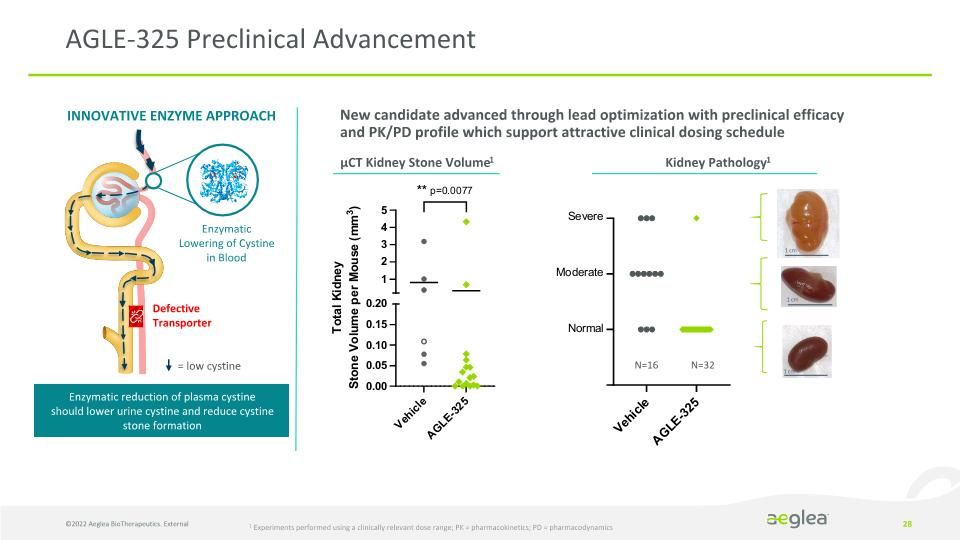
AGLE-325 Preclinical Advancement New candidate advanced through lead optimization with preclinical efficacy and PK/PD profile which support attractive clinical dosing schedule µCT Kidney Stone Volume1 Kidney Pathology1 N=16 N=32 INNOVATIVE ENZYME APPROACH Enzymatic reduction of plasma cystine �should lower urine cystine and reduce cystine �stone formation Defective Transporter Enzymatic Lowering of Cystine �in Blood = low cystine 1 Experiments performed using a clinically relevant dose range; PK = pharmacokinetics; PD = pharmacodynamics ©2022 Aeglea BioTherapeutics. External
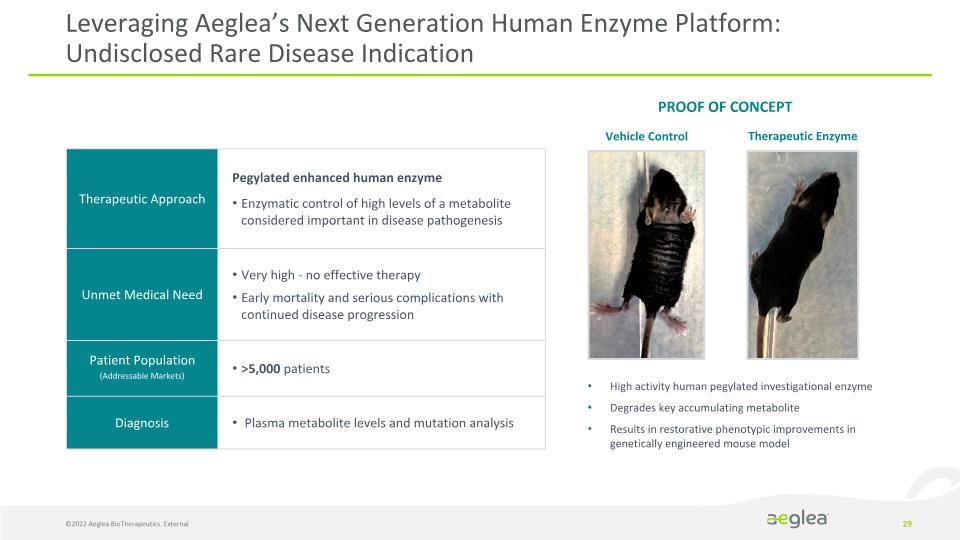
Leveraging Aeglea’s Next Generation Human Enzyme Platform: Undisclosed Rare Disease Indication High activity human pegylated investigational enzyme Degrades key accumulating metabolite Results in restorative phenotypic improvements in genetically engineered mouse model PROOF OF CONCEPT Vehicle Control Therapeutic Enzyme Therapeutic Approach Pegylated enhanced human enzyme Enzymatic control of high levels of a metabolite considered important in disease pathogenesis Unmet Medical Need Very high - no effective therapy Early mortality and serious complications with continued disease progression Patient Population (Addressable Markets) >5,000 patients Diagnosis Plasma metabolite levels and mutation analysis ©2022 Aeglea BioTherapeutics. External

Summary
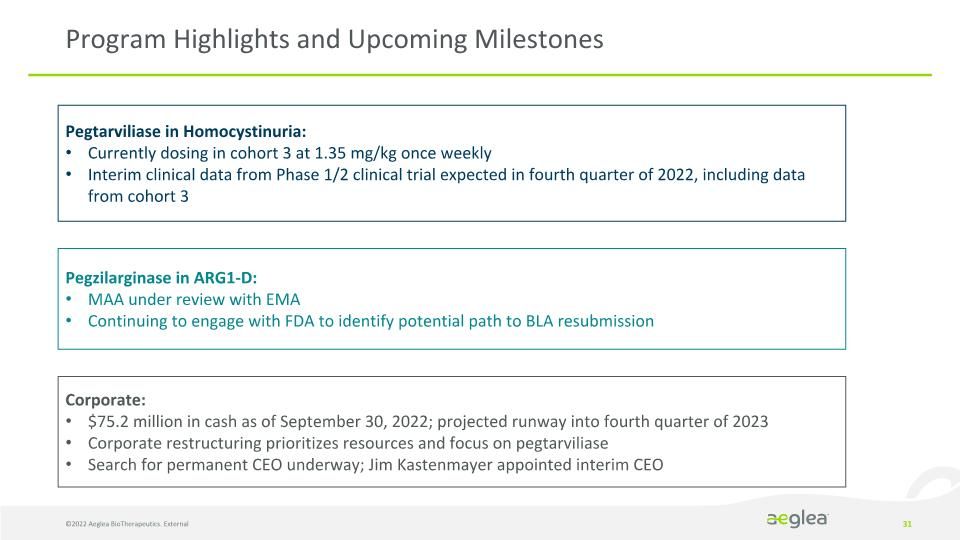
©2022 Aeglea BioTherapeutics. External Program Highlights and Upcoming Milestones Pegtarviliase in Homocystinuria: Currently dosing in cohort 3 at 1.35 mg/kg once weekly Interim clinical data from Phase 1/2 clinical trial expected in fourth quarter of 2022, including data from cohort 3 Pegzilarginase in ARG1-D: MAA under review with EMA Continuing to engage with FDA to identify potential path to BLA resubmission Corporate: $75.2 million in cash as of September 30, 2022; projected runway into fourth quarter of 2023 Corporate restructuring prioritizes resources and focus on pegtarviliase Search for permanent CEO underway; Jim Kastenmayer appointed interim CEO
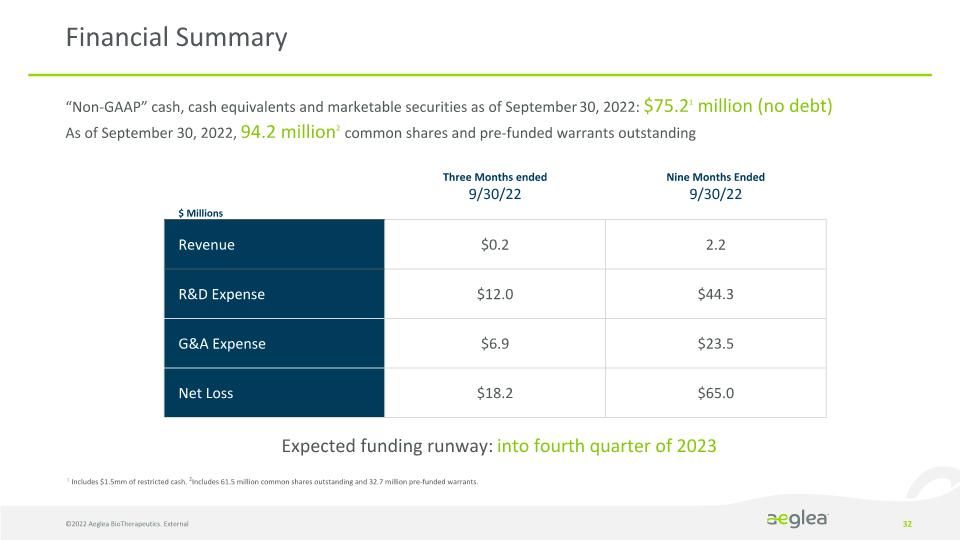
Financial Summary $ Millions Three Months ended 9/30/22 Nine Months Ended 9/30/22 Revenue $0.2 2.2 R&D Expense $12.0 $44.3 G&A Expense $6.9 $23.5 Net Loss $18.2 $65.0 “Non-GAAP” cash, cash equivalents and marketable securities as of September 30, 2022: $75.21 million (no debt) As of September 30, 2022, 94.2 million2 common shares and pre-funded warrants outstanding Expected funding runway: into fourth quarter of 2023 1 Includes $1.5mm of restricted cash. 2Includes 61.5 million common shares outstanding and 32.7 million pre-funded warrants. ©2022 Aeglea BioTherapeutics. External
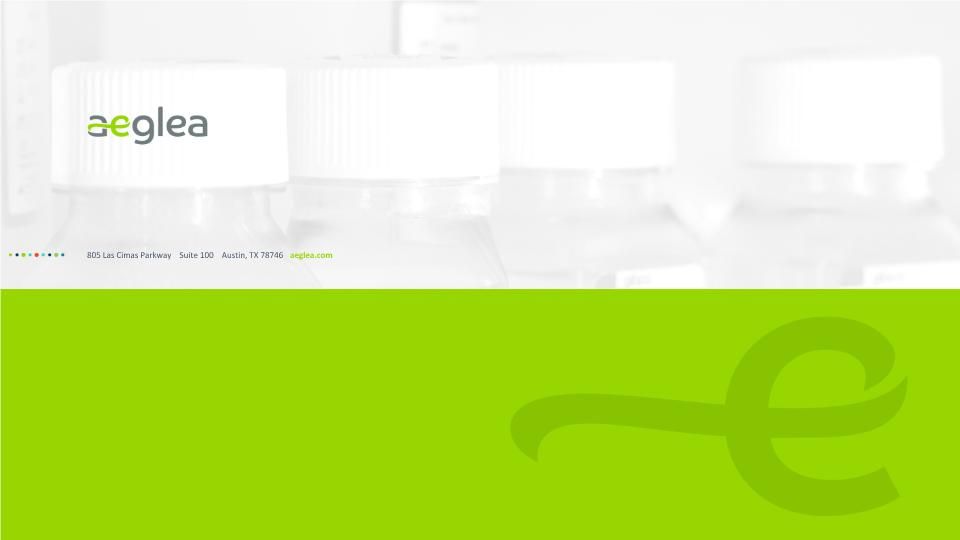
805 Las Cimas Parkway Suite 100 Austin, TX 78746 aeglea.com
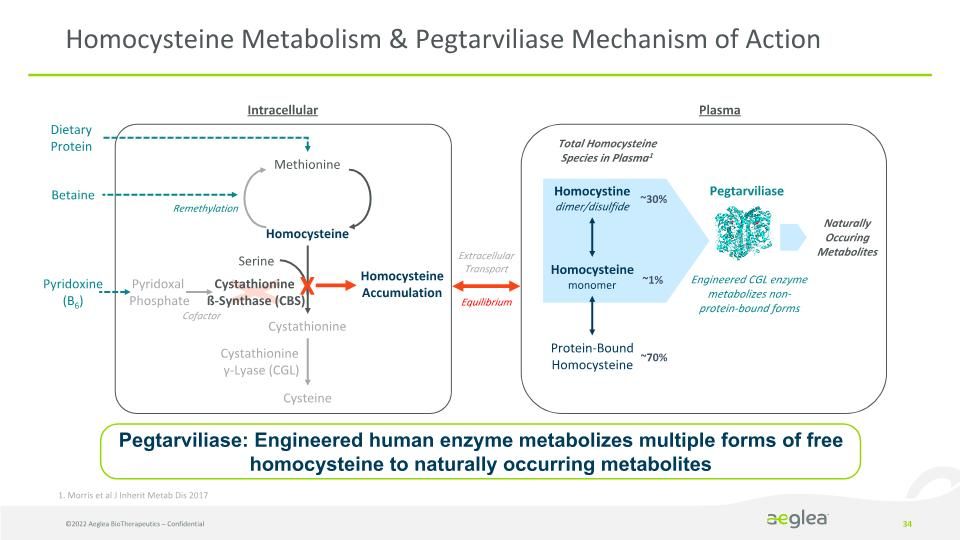
Homocysteine Metabolism & Pegtarviliase Mechanism of Action ©2022 Aeglea BioTherapeutics – Confidential Methionine Homocysteine Cystathionine Cysteine Cystathionine ß-Synthase (CBS) Homocysteine monomer Homocystine dimer/disulfide ~30% ~1% ~70% Protein-Bound Homocysteine Betaine Pyridoxine (B6) Intracellular Serine Dietary Protein Pegtarviliase Naturally Occuring Metabolites Engineered CGL enzyme metabolizes non-protein-bound forms Pyridoxal Phosphate X Cofactor Remethylation Cystathionine γ-Lyase (CGL) Homocysteine Accumulation Total Homocysteine Species in Plasma1 Extracellular Transport 1. Morris et al J Inherit Metab Dis 2017 Pegtarviliase: Engineered human enzyme metabolizes multiple forms of free homocysteine to naturally occurring metabolites Plasma Equilibrium
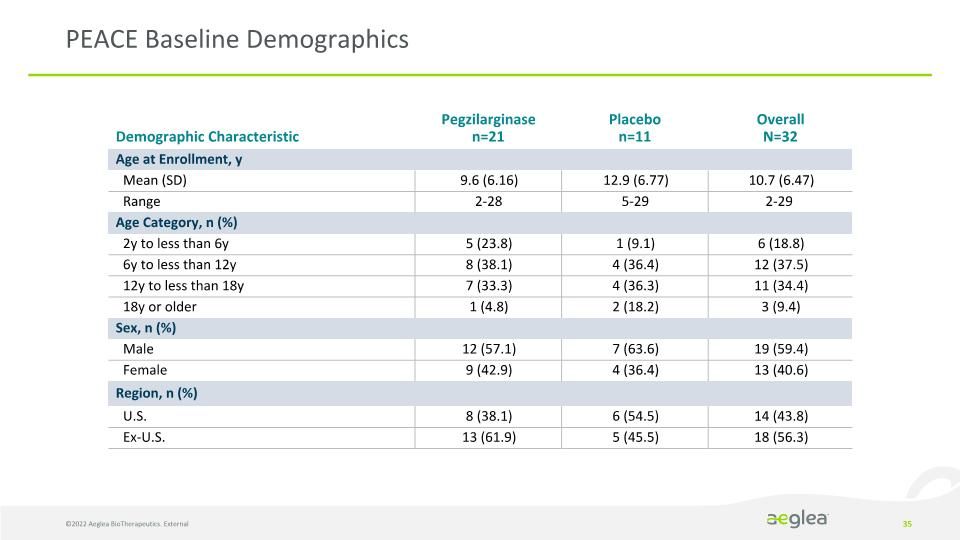
PEACE Baseline Demographics Demographic Characteristic Pegzilarginase n=21 Placebo n=11 Overall N=32 Age at Enrollment, y Mean (SD) 9.6 (6.16) 12.9 (6.77) 10.7 (6.47) Range 2-28 5-29 2-29 Age Category, n (%) 2y to less than 6y 5 (23.8) 1 (9.1) 6 (18.8) 6y to less than 12y 8 (38.1) 4 (36.4) 12 (37.5) 12y to less than 18y 7 (33.3) 4 (36.3) 11 (34.4) 18y or older 1 (4.8) 2 (18.2) 3 (9.4) Sex, n (%) Male 12 (57.1) 7 (63.6) 19 (59.4) Female 9 (42.9) 4 (36.4) 13 (40.6) Region, n (%) U.S. 8 (38.1) 6 (54.5) 14 (43.8) Ex-U.S. 13 (61.9) 5 (45.5) 18 (56.3) ©2022 Aeglea BioTherapeutics. External
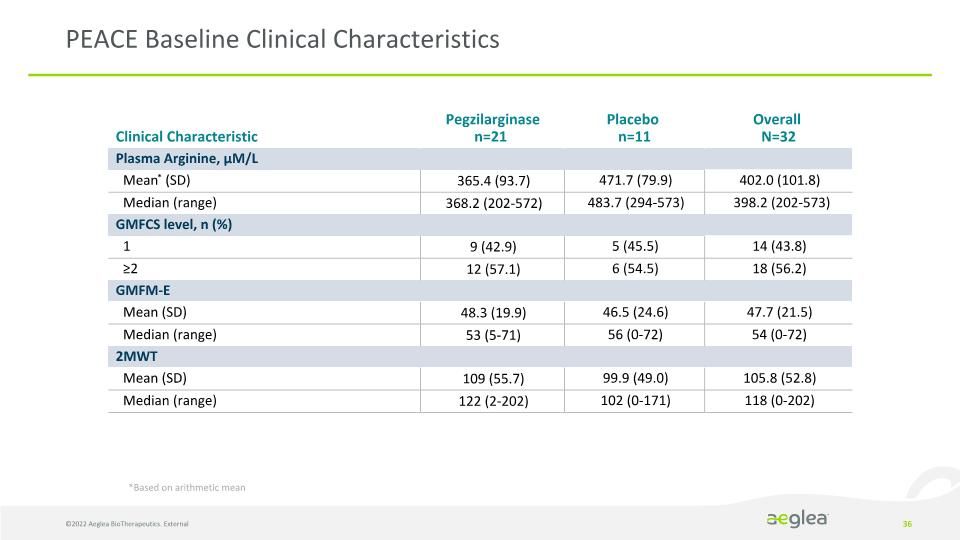
PEACE Baseline Clinical Characteristics Clinical Characteristic Pegzilarginase n=21 Placebo n=11 Overall N=32 Plasma Arginine, µM/L Mean* (SD) 365.4 (93.7) 471.7 (79.9) 402.0 (101.8) Median (range) 368.2 (202-572) 483.7 (294-573) 398.2 (202-573) GMFCS level, n (%) 1 9 (42.9) 5 (45.5) 14 (43.8) ≥2 12 (57.1) 6 (54.5) 18 (56.2) GMFM-E Mean (SD) 48.3 (19.9) 46.5 (24.6) 47.7 (21.5) Median (range) 53 (5-71) 56 (0-72) 54 (0-72) 2MWT Mean (SD) 109 (55.7) 99.9 (49.0) 105.8 (52.8) Median (range) 122 (2-202) 102 (0-171) 118 (0-202) *Based on arithmetic mean ©2022 Aeglea BioTherapeutics. External
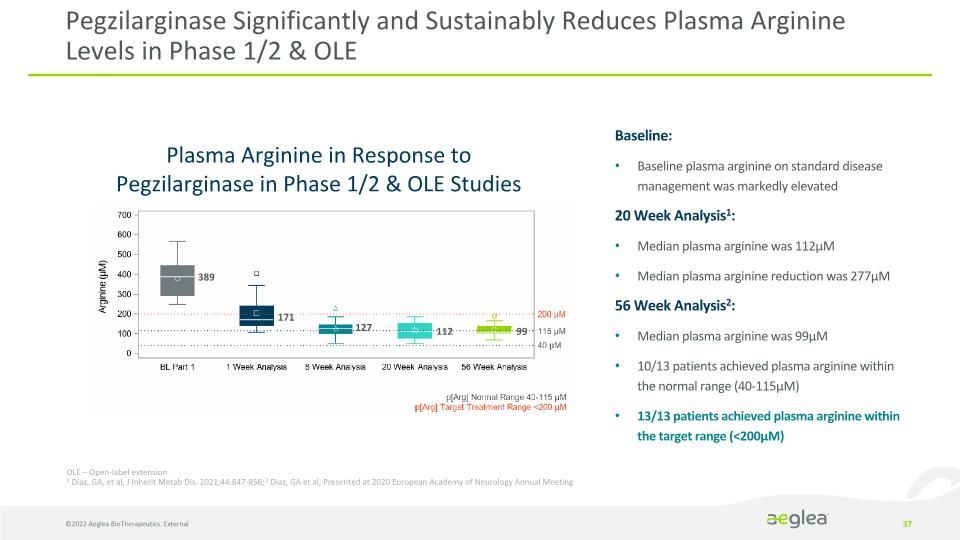
Pegzilarginase Significantly and Sustainably Reduces Plasma Arginine Levels in Phase 1/2 & OLE Plasma Arginine in Response to �Pegzilarginase in Phase 1/2 & OLE Studies Baseline: Baseline plasma arginine on standard disease management was markedly elevated 20 Week Analysis1: Median plasma arginine was 112µM Median plasma arginine reduction was 277µM 56 Week Analysis2: Median plasma arginine was 99µM 10/13 patients achieved plasma arginine within the normal range (40-115µM) 13/13 patients achieved plasma arginine within the target range (<200µM) 389 171 127 112 99 OLE – Open-label extension 1 Diaz, GA, et al, J Inherit Metab Dis. 2021;44:847-856; 2 Diaz, GA et al, Presented at 2020 European Academy of Neurology Annual Meeting ©2022 Aeglea BioTherapeutics. External
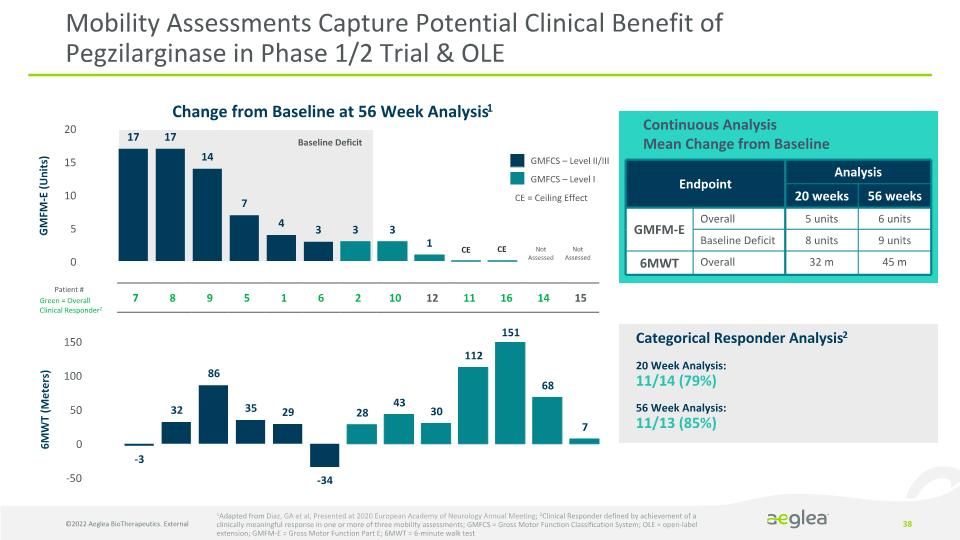
Mobility Assessments Capture Potential Clinical Benefit of Pegzilarginase in Phase 1/2 Trial & OLE Continuous Analysis Mean Change from Baseline GMFCS – Level II/III GMFCS – Level I CE = Ceiling Effect 20 Week Analysis:�11/14 (79%) 56 Week Analysis:�11/13 (85%) Categorical Responder Analysis2 1Adapted from Diaz, GA et al, Presented at 2020 European Academy of Neurology Annual Meeting; 2Clinical Responder defined by achievement of a clinically meaningful response in one or more of three mobility assessments; GMFCS = Gross Motor Function Classification System; OLE = open-label extension; GMFM-E = Gross Motor Function Part E; 6MWT = 6-minute walk test Change from Baseline at 56 Week Analysis1 Not Assessed Not Assessed CE CE 7 8 9 5 1 6 2 10 12 11 16 14 15 Green = Overall Clinical Responder2 Patient # GMFM-E (Units) 6MWT (Meters) Baseline Deficit 151 Endpoint Analysis 20 weeks 56 weeks GMFM-E Overall 5 units 6 units Baseline Deficit 8 units 9 units 6MWT Overall 32 m 45 m ©2022 Aeglea BioTherapeutics. External
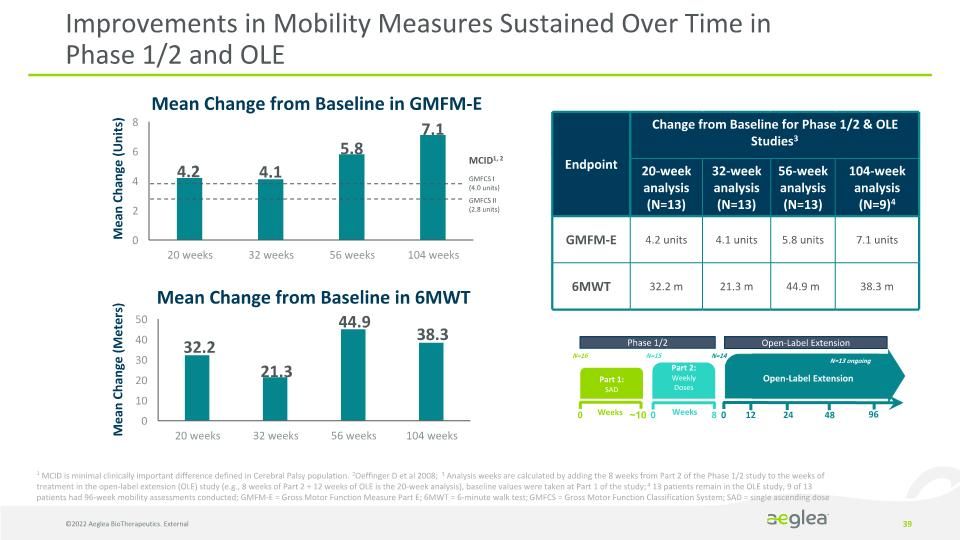
Improvements in Mobility Measures Sustained Over Time in Phase 1/2 and OLE Endpoint Change from Baseline for Phase 1/2 & OLE Studies3 20-week analysis (N=13) 32-week analysis (N=13) 56-week analysis (N=13) 104-week analysis (N=9)4 GMFM-E 4.2 units 4.1 units 5.8 units 7.1 units 6MWT 32.2 m 21.3 m 44.9 m 38.3 m Part 1: SAD N=16 0 ~10 Weeks Phase 1/2 Part 2: Weekly Doses 0 8 Weeks N=14 N=15 24 96 0 Open-Label Extension 12 N=13 ongoing Open-Label Extension 48 1 MCID is minimal clinically important difference defined in Cerebral Palsy population. 2Oeffinger D et al 2008; 3 Analysis weeks are calculated by adding the 8 weeks from Part 2 of the Phase 1/2 study to the weeks of treatment in the open-label extension (OLE) study (e.g., 8 weeks of Part 2 + 12 weeks of OLE is the 20-week analysis), baseline values were taken at Part 1 of the study; 4 13 patients remain in the OLE study, 9 of 13 patients had 96-week mobility assessments conducted; GMFM-E = Gross Motor Function Measure Part E; 6MWT = 6-minute walk test; GMFCS = Gross Motor Function Classification System; SAD = single ascending dose Mean Change from Baseline in GMFM-E Mean Change from Baseline in 6MWT Mean Change (Units) Mean Change (Meters) MCID1, 2 GMFCS I (4.0 units) GMFCS II (2.8 units) ©2022 Aeglea BioTherapeutics. External
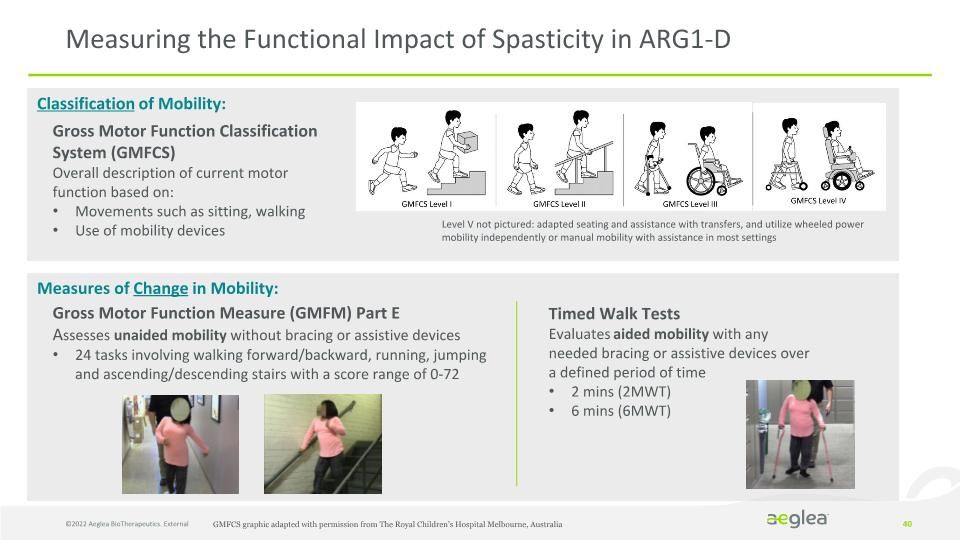
Measuring the Functional Impact of Spasticity in ARG1-D Gross Motor Function Classification System (GMFCS) Overall description of current motor function based on: Movements such as sitting, walking Use of mobility devices Gross Motor Function Measure (GMFM) Part E Assesses unaided mobility without bracing or assistive devices 24 tasks involving walking forward/backward, running, jumping and ascending/descending stairs with a score range of 0-72 Timed Walk Tests Evaluates aided mobility with any needed bracing or assistive devices over a defined period of time 2 mins (2MWT) 6 mins (6MWT) Classification of Mobility: Measures of Change in Mobility: Level V not pictured: adapted seating and assistance with transfers, and utilize wheeled power mobility independently or manual mobility with assistance in most settings GMFCS graphic adapted with permission from The Royal Children’s Hospital Melbourne, Australia ©2022 Aeglea BioTherapeutics. External
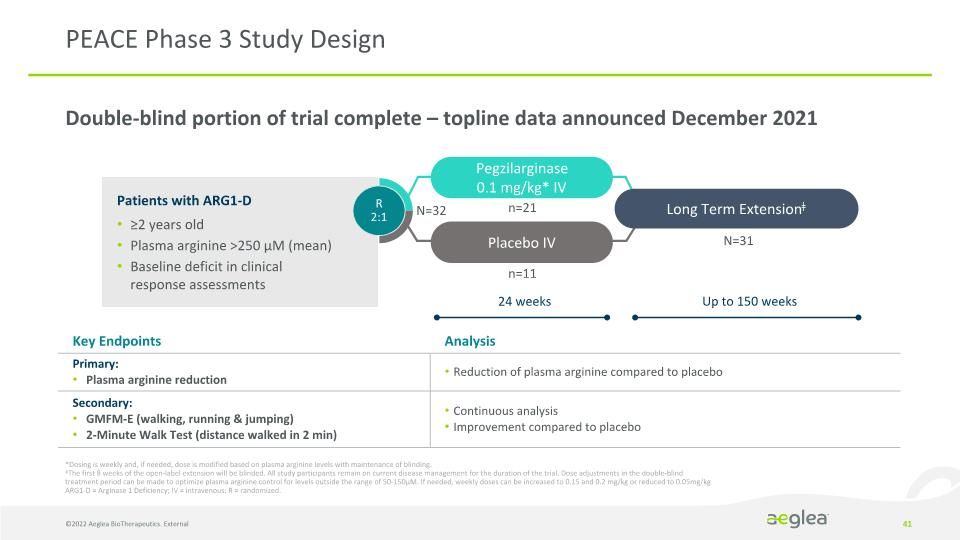
Double-blind portion of trial complete – topline data announced December 2021 Key Endpoints Analysis Primary: Plasma arginine reduction Reduction of plasma arginine compared to placebo Secondary: GMFM-E (walking, running & jumping) 2-Minute Walk Test (distance walked in 2 min) Continuous analysis Improvement compared to placebo PEACE Phase 3 Study Design *Dosing is weekly and, if needed, dose is modified based on plasma arginine levels with maintenance of blinding. ǂThe first 8 weeks of the open-label extension will be blinded. All study participants remain on current disease management for the duration of the trial. Dose adjustments in the double-blind treatment period can be made to optimize plasma arginine control for levels outside the range of 50-150µM. If needed, weekly doses can be increased to 0.15 and 0.2 mg/kg or reduced to 0.05mg/kg ARG1-D = Arginase 1 Deficiency; IV = intravenous; R = randomized. Patients with ARG1-D ≥2 years old Plasma arginine >250 µM (mean) Baseline deficit in clinical �response assessments Placebo IV R�2:1 Long Term Extensionǂ Pegzilarginase 0.1 mg/kg* IV 24 weeks Up to 150 weeks n=11 N=32 n=21 N=31 ©2022 Aeglea BioTherapeutics. External
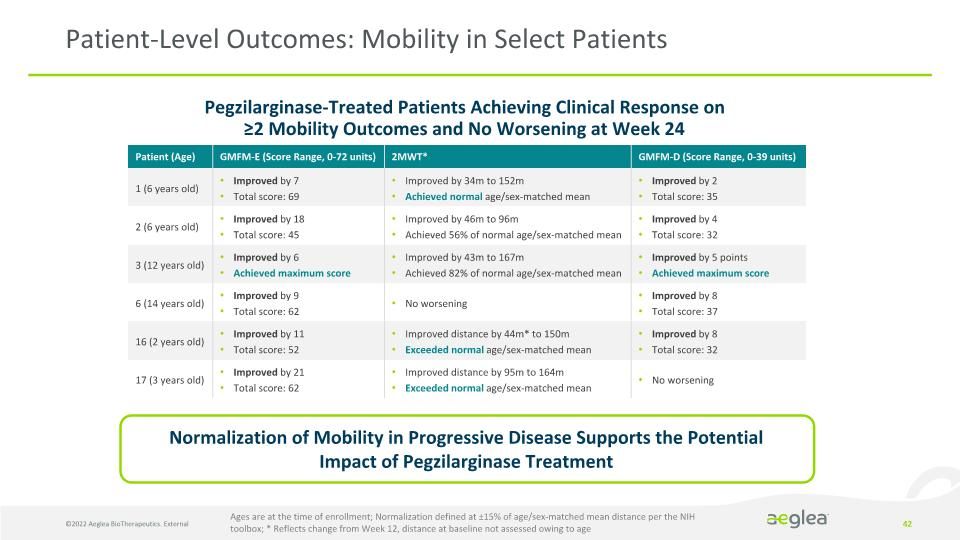
©2022 Aeglea BioTherapeutics. External Patient-Level Outcomes: Mobility in Select Patients Pegzilarginase-Treated Patients Achieving Clinical Response on ≥2 Mobility Outcomes and No Worsening at Week 24 Normalization of Mobility in Progressive Disease Supports the Potential Impact of Pegzilarginase Treatment Patient (Age) GMFM-E (Score Range, 0-72 units) 2MWT* GMFM-D (Score Range, 0-39 units) 1 (6 years old) Improved by 7 Total score: 69 Improved by 34m to 152m Achieved normal age/sex-matched mean Improved by 2 Total score: 35 2 (6 years old) Improved by 18 Total score: 45 Improved by 46m to 96m Achieved 56% of normal age/sex-matched mean Improved by 4 Total score: 32 3 (12 years old) Improved by 6 Achieved maximum score Improved by 43m to 167m Achieved 82% of normal age/sex-matched mean Improved by 5 points Achieved maximum score 6 (14 years old) Improved by 9 Total score: 62 No worsening Improved by 8 Total score: 37 16 (2 years old) Improved by 11 Total score: 52 Improved distance by 44m* to 150m Exceeded normal age/sex-matched mean Improved by 8 Total score: 32 17 (3 years old) Improved by 21 Total score: 62 Improved distance by 95m to 164m Exceeded normal age/sex-matched mean No worsening Ages are at the time of enrollment; Normalization defined at ±15% of age/sex-matched mean distance per the NIH toolbox; * Reflects change from Week 12, distance at baseline not assessed owing to age
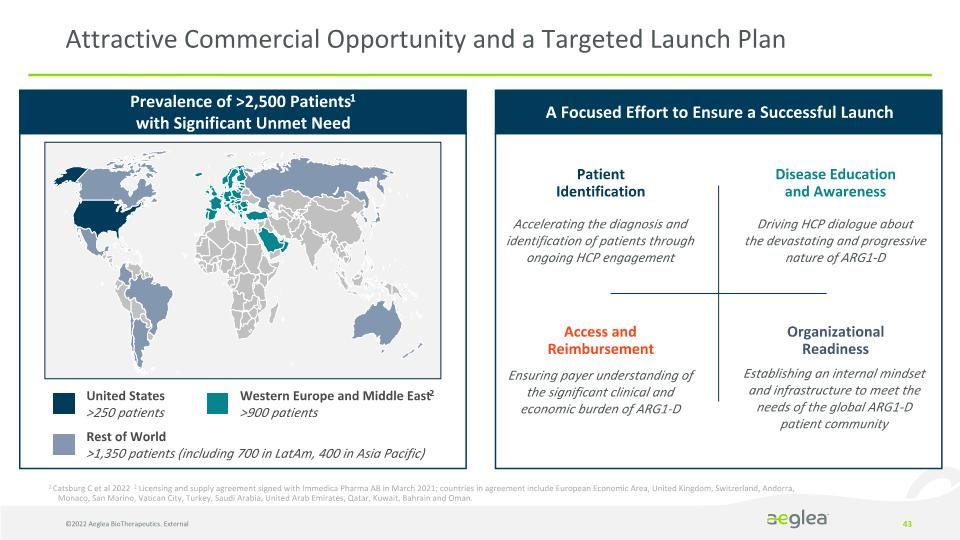
Attractive Commercial Opportunity and a Targeted Launch Plan 1 Catsburg C et al 2022 2 Licensing and supply agreement signed with Immedica Pharma AB in March 2021; countries in agreement include European Economic Area, United Kingdom, Switzerland, Andorra, Monaco, San Marino, Vatican City, Turkey, Saudi Arabia, United Arab Emirates, Qatar, Kuwait, Bahrain and Oman. Prevalence of >2,500 Patients1�with Significant Unmet Need United States >250 patients Western Europe and Middle East2 >900 patients Rest of World >1,350 patients (including 700 in LatAm, 400 in Asia Pacific) Patient�Identification Accelerating the diagnosis and identification of patients through ongoing HCP engagement Disease Education�and Awareness Driving HCP dialogue about the devastating and progressive�nature of ARG1-D Access and Reimbursement Ensuring payer understanding of�the significant clinical and economic burden of ARG1-D Organizational Readiness Establishing an internal mindset and infrastructure to meet the needs of the global ARG1-D patient community A Focused Effort to Ensure a Successful Launch ©2022 Aeglea BioTherapeutics. External










































